focusing on workforce and economic development issues





Your business is always evolving. As it does, TCC can work with you on everything from advanced manufacturing and process improvement to organizational effectiveness. Contact us today to learn more.

Preparing students for the jobs of today is historically the mission of Tarrant County College (TCC). Understanding the workforce ecosystem of Tarrant County and having relationships with our community partners and employers is key to everyone’s success. Since our establishment in 1965, TCC has made it a point to exhibit adherence to and transparency of our values:
• Student Success: Belief in providing quality instruction, resources and support services to assist our students in achieving their lifelong goals
• Access: Belief in providing educational opportunities for all members of the community

• Excellence: Belief in providing outstanding quality educational programs, administrative support and services to its students, faculty and staff
• Diversity: Belief that TCC should reflect the diversity of the community
• Innovation and Creativity: Belief in cultivating a learning environment that evaluates and incorporates emerging technologies and methodologies to enhance the quality of instruction and administrative support for our students, faculty and staff
We are fiercely proud of our track record. TCC graduates with associate’s degrees have gone on to some of the most prestigious institutions in the country. But we are not stopping there.

While TCC has steadfastly prepared students and workers for the careers of today, we know that in the digital and fastpaced high-tech age, we have to prepare the workforce for
the careers of tomorrow, even if those jobs do not exist yet. We are constantly meeting with industry leaders to make sure that TCC has its ear to the grindstone of academia and industry, and that Tarrant County’s workforce will be robust, educated and ready to meet the demands of industry.
To support our students, our employers and our community, TCC has adopted three key goals:
• One College: TCC will function as One College to provide a consistent and successful student experience.
• Student Ready College: TCC will put students at the core of all programs and services so they are welcomed, engaged and supported inside and outside the classroom.
• Serve the Community: TCC will serve the community and be its first choice for partnership.
It is through our values and our goals that TCC continues to keep its finger on the pulse of our community through quality teaching and learning. We continue to grow our services in Tarrant County, and we look forward to educating and preparing the next generation of college graduates and workforce participants.
Meet some of the amazing companies doing business in Tarrant County.
by vanessa orrLearning and development are critical to recruitment and retention of quality employees.
 by heide brandes
by heide brandes
Today’s workforce is in need of skilled employees more than at any point in the 21st century. This issue of The Lens speaks to that need and addresses how some Tarrant County companies are nurturing their workforce and helping young people enter the workforce early in their careers. The adage that a company is only as good as its employees is not only true, but it is evident in the employee programs offered to help foster both career and personal growth.
cover illustration by joshua knight
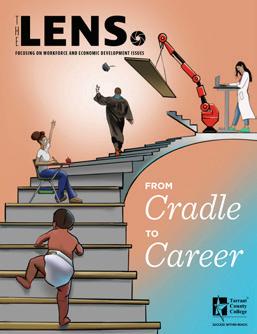
One of the greatest adventures in life is to learn. There is always something new to learn; there is always another question to ask. Our educational journey never stops. How many of us remember being asked as a child what we wanted to be when we grew up? I, personally, wanted to be a rock star. Unfortunately, I was not gifted with the talent of music. Thus, I gave up singing in the mirror with my hairbrush as a microphone and hit the books for new learning adventures that led me to the world of learning and development.
Think for a moment about asking a young child today what it is they might want to do when they grow up. With the innovation of today’s world, do the career opportunities in their future even exist now? Probably not. Hence, the vital importance of lifelong learning.
This edition of our award-winning magazine, The Lens, focuses on the magnificent work of our community partners and their mission to ensure our young people have an educational pathway from cradle to career. One example includes T3: Tarrant To & Through Partnership. The mission of T3 “aims to ensure more Tarrant County students have the training and skills they need to thrive in today’s workforce.”

Another example is Camp Fire First Texas. Camp Fire’s mission is “to invest in North Texas communities by providing out-ofschool time and outdoor learning programs for children and youth while also offering workforce development programs for early childhood educators.”
These are just a few institutions working diligently every day in Tarrant County to make certain our children are learning and growing toward a pathway of educational attainment, career success and impact to the overall economic health of our community.
We then meet a few of the thousands of employers in the region. We visit with executive leadership from businesses like MP Materials, Diamondback Industries, CoreCo USA, ITS ConGlobal, BrightCrowd and RECARO Aircraft Seating Americas, LLC. The innovative work of these businesses in our community is amazing. They are the current and future employers of our young people. I encourage you to get to know them.
It will take all of us to lift up and strengthen the education and skill-building of our workforce, now and tomorrow. Tarrant County College District is proud to be part of such a wonderful ecosystem, working around the clock to empower our people through education and lifelong learning.
Together, we all move to the head of the class.
Have thoughts on workforce and ecomonic development? Drop me a message at shannon.bryant@tccd.edu. I value your thoughts.

Teresa Ayala, President


Kenneth Barr, Vice President
Jeannie Deakyne, Secretary
Shannon Wood, District 2
Leonard Hornsby, Assistant Secretary Bill Greenhill, District 4 Gwendolyn Morrison, District 6 EDITORIAL ADVISOR
The Lens, published by Midwest Luxury Publishing, LLC, for TCC’s Department of Corporate Solutions & Economic Development, celebrates local corporations, workforce, residents and guests from around the world, giving TCC one of the most diverse portfolios in higher education.
All material is strictly copyright protected and all rights are reserved. No part of this publication may be reproduced in whole or in part without written permission of the copyright holder. All information and data are correct at the time of publication. Opinions expressed in The Lens are not necessarily those of Midwest Luxury Publishing, and Midwest Luxury Publishing does not accept responsibility for advertising content. Any images supplied are at the owner’s risk and are the property of the owner. Printed in the USA
jennifer blalock, edd
Jennifer has spent over two decades leading teams in post-secondary education and municipal government. As the CEO of InJenuity Solutions, Jennifer develops, facilitates and evaluates workforce, economic and organizational development programs.
heide brandes
Based in Oklahoma City, Heide is an award-winning journalist whose work has appeared in Forbes, The Wall Street Journal, The New York Times and The Washington Post, among others. She is also a historic re-enactor and an avid hiker.
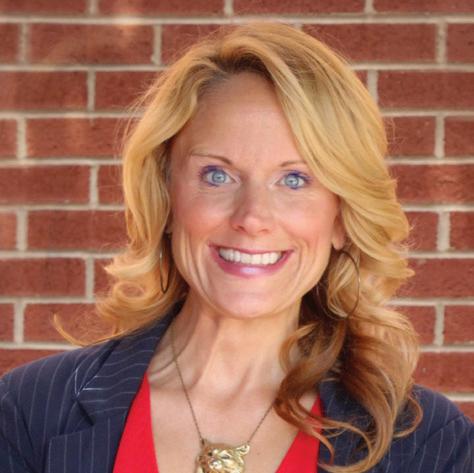
shika hershel, phd

Shika has published articles in various commercial and educational journals. She is also the former team photographer for the Texas Rangers. Shika currently works in risk management at Charles Schwab & Co.
james ndone, phd
James is an organizational and leadership communications scholar who specializes in crisis communication. Originally from Kenya, he has worked domestically and abroad in both education and industry. He has a PhD from the University of Missouri.


vanessa orr

Based in Pittsburgh, Pa., Vanessa has been a freelance writer and editor for more than 25 years. Her work has appeared in hundreds of regional and national publications including the Pittsburgh PostGazette and Alaska Business Monthly
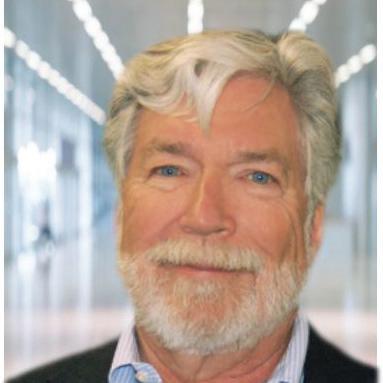
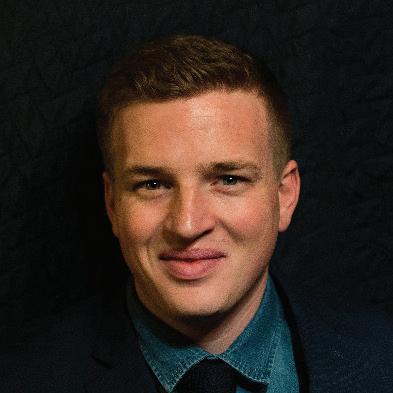
sam osterling
Sam is a team manager and freelance writer based in New York City. In his years of managing a large team, Sam learned volumes about sourcing, developing and retaining talented team members. He holds degrees from Ohio State and Oklahoma.


bennett root
Pasadena, California-based Bennett Root is a business advisor, mediator, arbitrator, attorney and author. He specializes in building innovative programs for SMBs and systems to reduce workplace conflict and build profits.
dan schlossberg
Dan Schlossberg of Fair Lawn, N.J., is the author of 40 baseball books.
He covers the game for forbes.com, Latino Sports, USA Today, Sports Weekly and Sports Collectors Digest
wendy m. weinhold, phd
Wendy is an associate professor of journalism and a faculty fellow at the Center for Inclusive Excellence at Coastal Carolina University in Conway, S.C. Her research focuses on the intersection of journalism, gender and democracy.



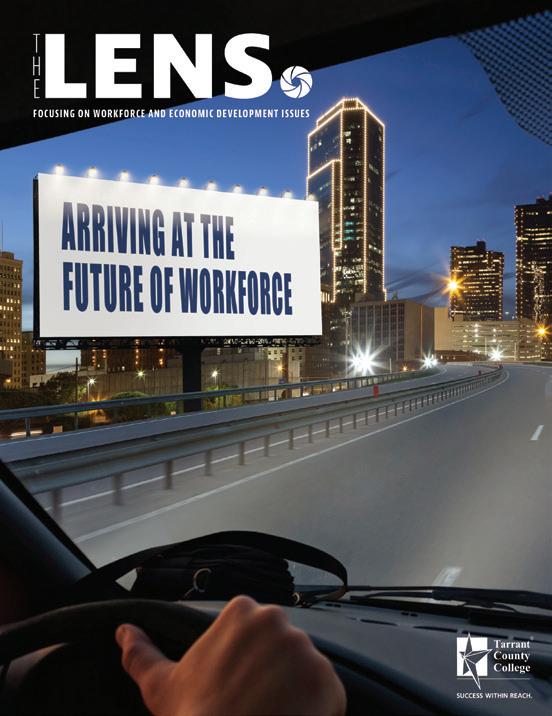
When you advertise in The Lens , you’ll reach an audience of influential leaders not just in Tarrant County, but throughout the North Texas region. What’s more, Fort Worth is the 12th largest city in the country, in part because like-minded business leaders are discovering what many locals have known for a while: This is one of the best places in the United States to strike the perfect work/life balance.

The stats behind one of the fastest-growing markets in the country.
 ck foto / shutterstock.com
ck foto / shutterstock.com
Tarrant To & Through (T3) prepares today’s youths for tomorrow’s careers. by shika hershel, phd

Parents want what’s best for their children, that is a given. But it’s hard to help maturing teenagers prepare for a career when the parents themselves don’t have their fingers on the pulse of the workforce. That’s where Tarrant To & Through (T3) Partnership comes in. Launched in 2020, T3 provides a variety of programs designed to inform and engage students and families about college and career pathways.
The Lens sat down with T3 Partnership Executive Director Natalie Young Williams to discuss T3’s goals, the importance of this entity for shaping career-minded minds and the bright future that awaits participants.
Why was the Tarrant To & Through Partnership program created?
The reason why we exist is to ensure more students in Tarrant County obtain postsecondary credentials and create pathways to economic prosperity.
Can you explain the mission, core values and key components of the program?
When we think about the T3 Partnership model, we refer to it as the T3 Connection Continuum. The continuum is a decade of support from grades six to 16. We have four student-facing program pillars—Parent and Family Engagement, Postsecondary Pathways, College and Career Success, and Mentoring and Workforce Development. Our fifth program pillar is Data and Technology because having data insights allows us to provide the best program support for our students and to strengthen our programs.
Parent and family engagement starts as early as middle school, so we work with parents and families to help them navigate what it means to create that next career or find their college pathway. In eighth grade, they have to select their endorsement. Sometimes it is difficult for parents and families to navigate, so we want to demystify that process and support families in making that decision alongside their student. We want them to find the pathway they are truly passionate about.
From there, we have a program pillar called Postsecondary Pathways. Students create their postsecondary success plan. They take a pledge and commit to furthering their educational
goals in order to be eligible for scholarships and other support, and then they pursue whatever that next step is on their career trajectory. If they choose the pathway to go to college, the College and Career pillar provides persistence support to complete their degree.


The fourth pillar is Mentoring and Workforce Development. We started as early as middle school with the exploration of Career Pathways, then we transition into high school, where we’re connecting students with mentors to support them on a career or college pathway. We continue that into college so that they have a professional mentor to not only help them on their career path but also to help them through that first year on the job. Whether they’re looking to go directly from college into the workforce or if they earn a certification or industry credential, we want to help them be successful in their chosen career path.
All the pillars build upon each other and are interconnected. This ensures a strong foundation of support as students move along the continuum to find the career or college pathway. Our T3 tagline is ‘Clear Pathways. Bright Futures.’ We want all students to find the best-fit pathway to a bright future.
“Our T3 tagline is ‘Clear Pathways. Bright Futures.’ We want all students to find the best-fit pathway to a bright future.”
— Natalie Young Williams EXECUTIVE DIRECTOR



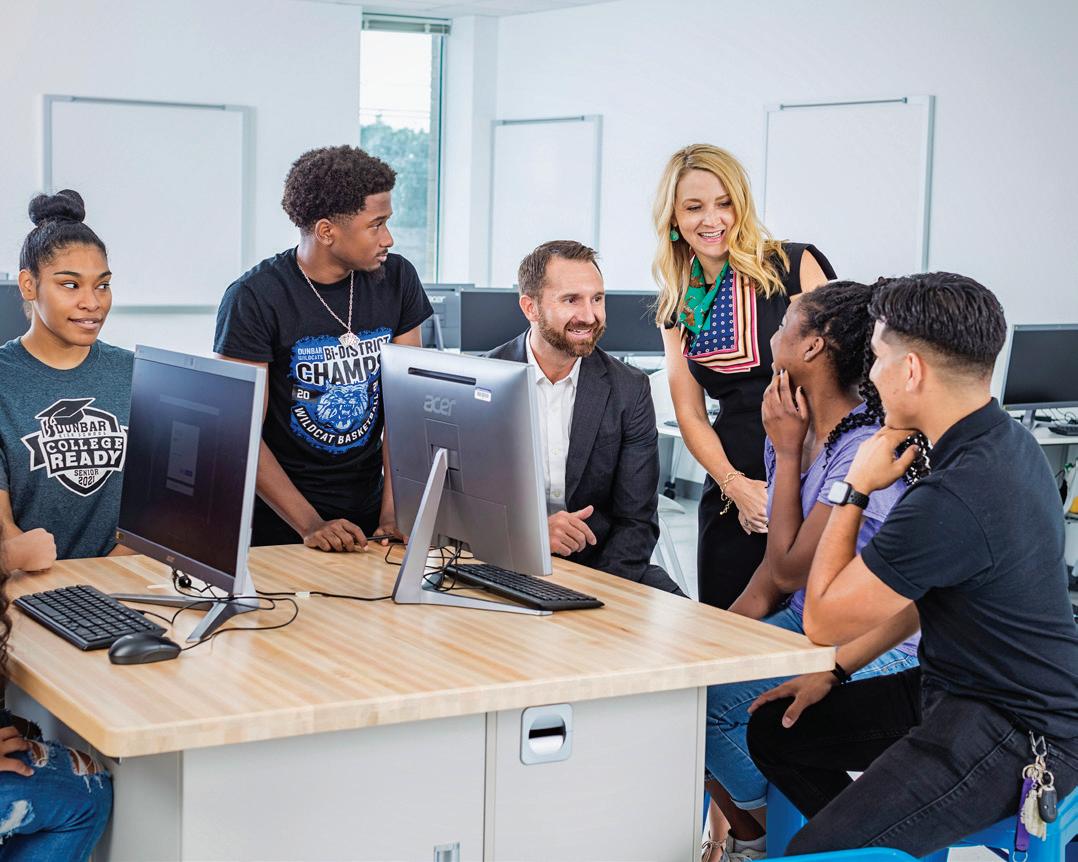



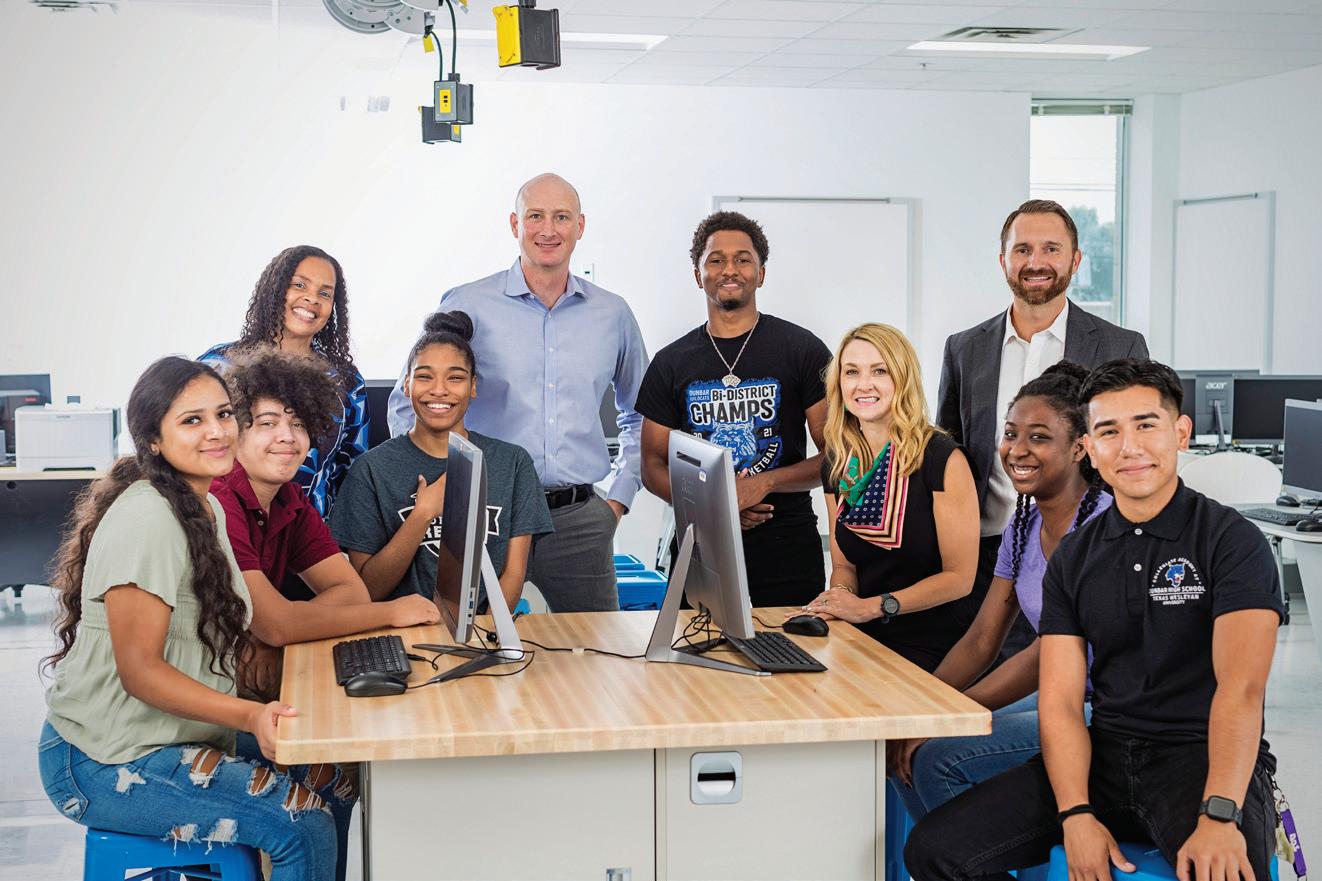
Who is eligible to participate in the program?
We partner with school districts and work closely and intentionally with students. All students are eligible to take the pledge, so every single student in our partner school districts is eligible. We work primarily with sophomores, juniors and seniors in our high schools. We also started working with three middle schools. We’re in Fort Worth ISD as well as Crowley ISD. When a student takes the pledge, they become a T3 scholar.
What can students expect while being in the program, and what does the postsecondary pathway look like?
For starters, the student will have a support system along the way. Our T3 team members understand the hurdles, obstacles and challenges of navigating college or your career pathway, especially if they’re the first person in their family that’s going on to college.
We hope that the students view T3 as a partner in their educational journey that listens to them, understands their passions and their desires and really helps them connect all those steps along the way to reach their fullest potential.
Can you explain the funding and scholarships offered in the program for postsecondary students?
Each institution of higher education has an income threshold that a student or their family must meet in order to qualify for the Last Dollar tuition scholarship, which funds the gap between the cost of tuition and the financial aid or scholarship awards. For example, if a student is Pell Grant eligible, whatever the difference is between scholarships or federal funding and the Pell Grants, our partner institutions of higher education agree to fill in the tuition gap.
In terms of the First Dollar scholarships, we provide students who meet income thresholds and remain in good standing $250 per semester. The money goes directly to the student, and they’re able to utilize that for books or any necessities that they may need.
Our model addresses barriers to access by eliminating financial, information and advising gaps and creates pathways to economic prosperity by ensuring all students can attend a postsecondary institution of their choice tuition-free if they meet income thresholds or earn an industry credential.

How can businesses participate in the T3 program?
We love to have employees in businesses sign up to mentor students in industries that align with their interests and what they’re looking to pursue upon high school or college graduation. The other way businesses can participate is by providing job opportunities for students. What we see is that students who can connect with individuals in companies with career paths they are interested in, especially when it’s their first job or the first step in their career, are more likely to be successful, feel welcomed and navigate that first year of transition into a new job.
What is the T3 program’s postsecondary completion rate?
We just had our first cohort finish their first year in college and our second cohort is entering their first year of college. We added about 500 more students in our second cohort for a total enrollment of just under 1,500. We had about an 85% persistence rate from fall to spring. We are just now receiving our freshman to sophomore persistence rates and we are seeing solid retention.
Just a few miles southwest of Fort Worth sits Camp El Tesoro. Situated on the north side of the Brazos River, the camp has stood for nearly 100 years and features basketball courts, fishing, swimming, archery and all the other fun activities that make camp memorable. It’s operated by Camp Fire, a national youth development organization that serves over 300,000 people nationwide each year. But there’s more to the camp than just summer fun, for Camp Fire’s purpose is to prepare a future workforce through activities.
According to Camp Fire First Texas President and CEO Lauren Richard, the organization takes several approaches to create future leaders in the workforce. “So many soft skills aren’t prioritized as much as academic knowledge,” she says. “That’s what teachers want, and that’s what employers need.”
The organization uses several programs and camps to build a more empathetic workforce filled with critical thinkers.
Camp Fire’s Early Education Workforce Development program works to build the workforce both directly and indirectly. The program offers an Early Education Apprenticeship Program specifically for educators in Texas.
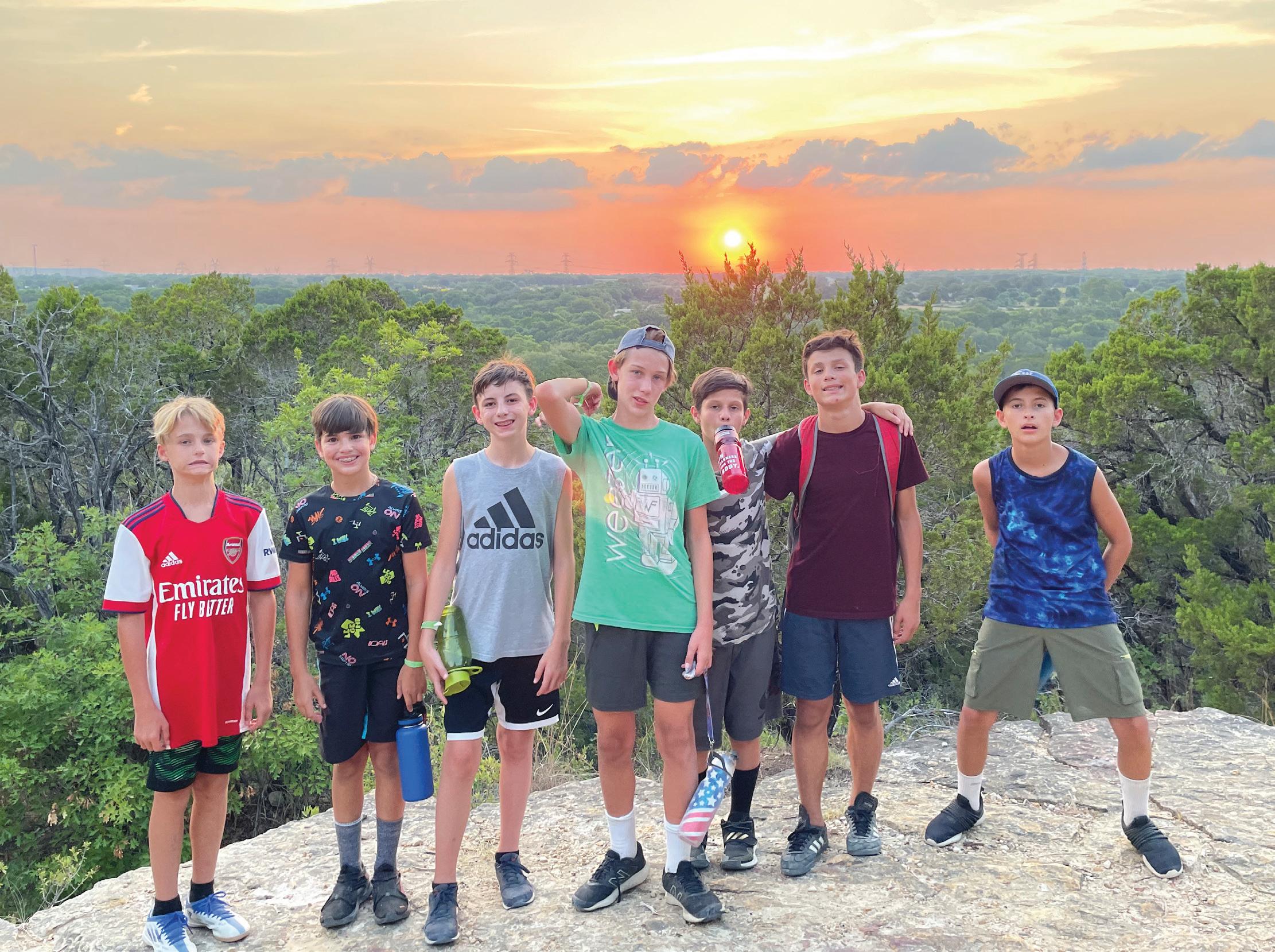
“We go into early childhood centers and provide teachers with training, credentialing and mentoring to provide high-quality education to young children,” Richard says. The program is fully registered with the U.S. Department of Labor and trains educators in everything from appropriate teacher-student interactions to proper assessment of students.
Richard says Camp Fire’s teacher education comes with a “focus on language development, conscious discipline, social
Camp Fire delivers life lessons for campers and counselors alike.all images courtesy of camp fire first texas








“Our value of inclusion has been with us since our inception.”
and emotional skills.” They’re also sure to spend a lot of focus on outdoor spaces for young children to learn.
On top of educating and training teachers, there’s also a program to earn the Early Childhood Administrator’s Credential. That training features management and leadership training along with helping students understand the best business practices in early childhood education.

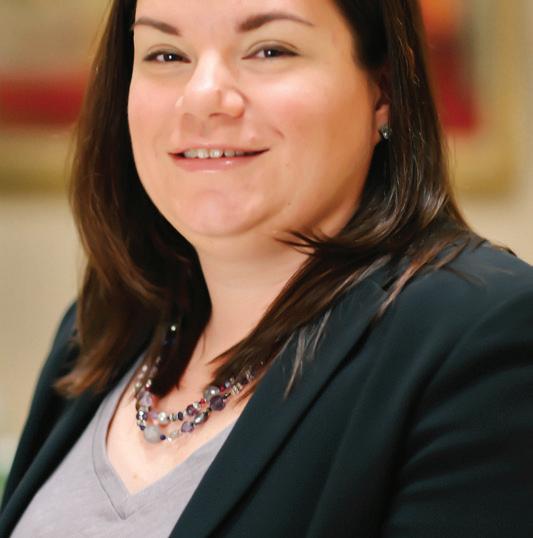
And then, of course, there are the titular camps. The organization was forced to shutter the summer camp during the pandemic, but Richard reports that since then, the camp has grown year over year.
“After COVID, we closed camp for the only time in our history,” she says. “The next year we had a lot of COVID protocols, so it wasn’t the same camp. This last summer was amazing. It was camp as usual, and we had one of the best years: over 875 kids out there.”
There are myriad programs at Camp El Tesoro throughout the summer. There are weeklong and two-week sessions for children of all ages, weekend camps and even camps for children who’ve recently lost a loved one.

During these camp sessions, the organization works to ensure that kids are learning the soft skills and critical thinking that’ll carry them through their education and work life. “Everything is tied to the state of Texas’s educational standards,” Richard says. “For counselors, it’s a great opportunity to get leadership skills and decision-making skills.”
Richard says the camp setting allows campers
and counselors alike to put lessons into practice in the real world. It’s one thing to tell kids about how leadership and inclusion are important; it’s another to encourage them to take action.
As a prime example, Richard tells a story about a group of kids she watched as they worked through the rope course. One child was “petrified,” she says. Instead of the kids turning to the counselors or camp organizers to deal with the kid who was

“So many soft skills aren’t prioritized as much as academic knowledge. That’s what teachers want, and that’s what employers need.”
— Lauren Richard PRESIDENT AND CEO OF CAMP FIRE FIRST TEXAS
unable to continue through the course, the counselors let the kids figure out a solution.
“They were practicing empathy, problem-solving—how do we get him up there?” Richard says. “Talking him through it, they were able to help him without anything from the adults.” The ability to empathize and use creative problem-solving to find solutions is a skill Richard says carries over into the workforce.
“It’s not just talking about these things,” she says. “When it’s
time to actually implement them, you don’t take the opportunity away from the kids.” The scared child finished the rope course, though it wasn’t his favorite part of camp.
The counselors, all of whom are 18 and older, receive training and certifications to make the experience feel like a job—which it is. They receive paychecks, professional development and are able to earn college credit or other certifications on the job. And the organizers make sure their voices are heard.





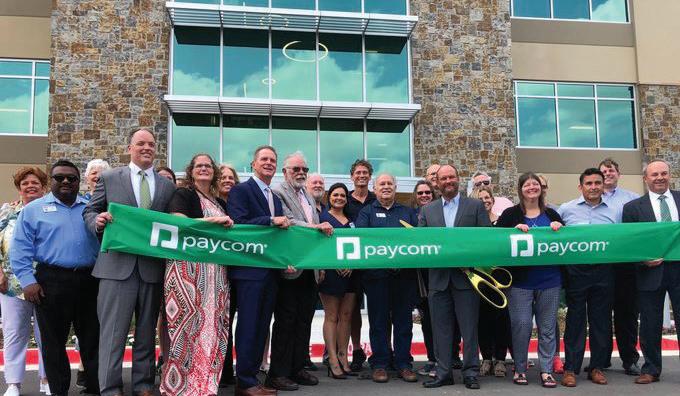
Camp Fire First Texas uses data to guide their decision-making at camp through surveys and other assessments carried out by Camp Fire’s national office. What went well at camp this year? What didn’t? What could we change? Counselors are directly able to use those critical thinking and communication skills to guide camp. “Our value of inclusion has been with us since our inception,” Richard says.
Whether it’s kayaking, archery or dance, Richard says that kids at Camp El Tesoro are helping create a more vibrant, capable workforce. The younger children are learning about discipline and being present, while the older kids are learning about leadership, communication and collaboration. The soft skills they learn on the Brazos River help them become better students, workers, and in due time, leaders.

Two problems predominate most contemporary business meetings: “I can’t find enough [qualified] workers” and “We can’t get enough parts/supplies/raw materials.” Either way, requirements are not being met in the supply chain. Excuses are many; solutions are few. But it need not be that way.
The truth is that most businesses work much harder (and more effectively) when trying to land customers or in resolving material shortages than they do when trying to address their staffing challenges. For most employers, a little more focused thought—and more effective outreach—could meet crucial postpandemic staffing shortages. And the good news for employers: You will significantly level up your HR game by doing this.
Employer woes about vacant positions—public employers, private employers, production employees, office employees—are often myths masquerading as excuses, not realities. Consider:
• Myth: The pandemic made the young workforce disengaged—happy to sit around at home on their parents’ dole. Reality: Most young people are anxious to get out on their own, but they are uncertain about how to do this.
• Myth: High schools and colleges are not training their students for today’s jobs and there are simply not enough qualified job applicants. Reality: Usually there are qualified students, but you are not getting the pick of the litter.
• Myth: New employees just want to take the signing bonus benefits and then parlay their experience elsewhere. Reality: Changing jobs is hard and usually comes with significant risk. Incentivize your new hires to stay with you and you can beat the employee turnover carousel.
And the ultimate reality: Unsolved employment issues threaten your business just as much as unmet sales quotas or unfilled raw materials orders.
For months now, long after the pandemic was the top news story, uncontrolled and unmanageable problems for most employers concerned staffing challenges. For many, those challenges are getting worse. And if that were not headache enough, as technology creates new business efficiencies, skill demands are moving more quickly than available skill resources.
Being proactive with a wellorganized plan is the first step in addressing a staff shortage.
These increasing skills gaps portend even greater problems as we stagger forward in an economy few of us fully understand. Skills gaps are not temporary; they are long-term, post-pandemic, new-normal realities. What we see is that employers who continue with old strategies and tired tactics are not meeting new recruitment challenges. Short-term “bandaid” incentive strategies such as recruitment bonuses or even systemic compensation adjustments will only be effective until the competitor down the street matches those incentives. Or beats them. Either way, the challenges will remain.
Better solutions center around more education and training of employees. Specifically, education for employees that is more focused on closing skills gaps. Yet having a pool of better-trained workers does not assure that your employment vacancies will get filled. So how do you attract new workers while retaining the ones you have?
You likely already use the techniques you will want to adopt for cutting into that list of vacancies. Do become reactive; build a proactive plan to surround and attack the problem.

First, as is often said but too often ignored, get to “know thyself.” Before you seek new talent for old work structures and
processes, consider customer requirements that may change how you can best address your markets. Accenture notes in a recent website posting: “A zero-based approach to reinventing your future workforce [is best]. Take a fresh look across your entire workforce to find where you can stop doing work by changing standard operating procedures, simplifying processes and deploying technology more effectively.”
And as Forbes counsels, “talk with your existing employees,” the ones who have been getting the job done over the past 30 to 40 months. Operating changes forced by the pandemic have often revealed new efficiencies, which mean different skills should be deployed (or deployed differently) and a reduced head count may be possible.
Listen particularly to their desires and their fears. These are the motivators that drive sales, and you are selling the idea that working for you would be a great idea for them.
Second, determine where your preferred new employees are now. In school? Working for a competitor? In a low-wage site out of state? As you would with any marketing problem, locate your targets and figure out how to interrupt them. Then, ask them what it would take to get them to become part of your team. Listen particularly to their desires and their fears. These are the motivators that drive sales, and you are selling the idea that working for you would be a great idea for them.
Third, create incentives that meet prospective employees’ desires (I want a job with a future so I can send my kids to college) or alleviate their fears (I need a job that will allow me to navigate an uncertain future). This last step should produce something more thoughtful than a signing or retention bonus, a benefit too soon forgotten. Consider longer-term training incentives that pay for performance over time. Incentives that are forward investments will pay substantial dividends as technology and AI change future workplaces.
Which brings us back to the desirability of more education. If your target new employee is a student at, say, a local high school or college, reach out and connect through the school’s counseling or career placement office. Post-pandemic students have all the usual fears about starting a new job and a new life, but also new fears of a post-pandemic job market and economy. Listen to their concerns and create a specific learn-work program(s) for
the skill sets you need. Understand that students can easily get educational loans, but paying those loans back is a persistent worry. To address that concern (and to incentivize their coming to work for you when the education part is complete), consider an employment incentive that matches their loan repayments dollar-for-dollar. It is a great way to recruit new talent but at the same time, it assures talent engagement and retention. A similar program might be designed for recruitment of those already employed but whose skills you will need as the future of work unfolds.

Vacancies in your workforce present pressing, persistent problems. Resolving these problems using the techniques suggested adds cost, to be sure, but foremost, the cost of solving the problem is much less than the cost of unresolved workforce problems measured by lost customers, lost market share and lost profits.
Facilitating workforce development by integrating your employee recruitment and retention with outside educational programs can address those staffing woes that are urgent today and growing. Creative and careful program design will be rewarded. As Sun Tzu famously advised, “The battle is won before it is ever fought.” Plan first, then execute a comprehensive strategy. Reach out. Listen well. Build a pathway to your office or plant. Make continuing education and skills development a part of your culture. This will allow you to both adjust to a post-pandemic economy and build a winning workforce for the future, regardless of what the future holds.









hen companies decide where to set up shop, owners take a lot of factors into account. From transportation access to zoning rules and regulations, from workforce availability to whether their employees will want to live in the location and send their children to school there, scores of decisions are stirred into the relocation pot.

According to six Tarrant County companies—ranging from those new to the area to those who have been located here for decades—the greater Tarrant County area checks all of the boxes when it comes to helping their businesses and employees succeed.

Meet some of the amazing companies doing business in Tarrant County.




MP Materials is one of the newest additions to Tarrant County, and they are putting down roots in a big way. In 2021, the company announced that it would be breaking ground in April 2022 on a rare earth metal, alloy and magnet manufacturing facility in Fort Worth.
Headquartered in Las Vegas, MP Materials is the largest rare earth materials producer in the Western Hemisphere, and owns and operates Mountain Pass, America’s only active and scaled rare earth mining and processing site, located in San Bernardino County, California.

“We ran a very careful process to decide what was important to us in order to find an area that fit us,” says Alan Lund, executive director of magnetics at MP Materials. “The fact that DFW is close provides key infrastructure—the airport is a great transportation hub, and there are also a lot of transshipping options nearby including railways, highways and the Alliance, Texas, commercial airport.
“There’s a lot to like about this area from an infrastructure perspective, and on top of that, there is a great academic community and a ready workforce here,” he adds. “We will be recruiting all different types of people from operators on
the factory floor to business development professionals and engineers, and we will be able to recruit locally for all types of positions.”
The new manufacturing facility, located in Hillwood’s 27,000acre, mixed-use development AllianceTexas, is currently under construction and is expected to be completed in 2023. “We’re very happy with the construction progress, and Hillwood did a great job in laying the groundwork for an industrial facility,” Lund says.
“As we’ve interacted with local regulators, we’ve had very positive conversations and have been able to work with them and engage with them to find solutions to any issues,” he adds. “This type of collaborative relationship allows us to build something that is world-class in terms of how it performs from an environmental impact and worker safety perspective, and to do it in a timely manner.”
The new facility will allow MP Materials to continue its corporate mission to restore the full rare earth supply chain to the United States.
“We live this mission every day,” Lund says of the company that mines rare earth materials from the ground in California

and then converts them into high-powered magnets used to power electric vehicles, defense systems, wind turbines, robotics and more.
The AllianceTexas facility will be unique in the U.S. as it will be the first fully integrated domestic manufacturing facility to turn rare earth materials into high-powered magnets all under one roof, restoring a fully vertically integrated U.S. magnetics supply chain. This tidbit is extremely important when considering that 90 percent of global rare earth magnet production takes place in China. “We’ll be bringing back technology that was largely pioneered in the U.S. Instead of manufacturing offshore; we’ll be using our resources to manufacture onshore.”

The facility will have the capacity to produce approximately 1,000 tons of neodymium-iron-boron (NdFeB) magnets per year, and MP Materials recently signed an agreement to produce alloy and magnets for General Motors’ electric vehicle program. “GM has other operations in the region, and we’re pleased to expand that local economic impact by becoming a key supplier for them,” Lund says.
MP Materials expects to create 1,300 indirect jobs through the construction phase and will employ approximately 150 skilled workers when the facility is completed. The company currently employs approximately 500 people at its sites in Texas, Nevada and California.
“Looking at the workforce and academic environment here, we appreciate that there are great research universities and large land-grant universities, but I have to say that I have been most impressed by the strength of the community college system and the breadth of the skills that students are learning there,” Lund says. “I also appreciate their willingness to engage with companies on ongoing professional development, and it’s been a happy surprise to see that their goals of helping local people build professional careers and helping companies build workforces are so well-aligned with our needs.”
MP Materials promotes an owner/operator culture, where they encourage employees to take ownership—and responsibility—for the company’s mission. “We want them to have a voice and to use that voice, and we want to create an environment where that voice has an impact,” Lund says. “We want everyone here to be passionate about our mission, as it helps us better perform as a company and makes for happier, more productive employees.”
Keeping its workforce happy is important to the company, which is just one more reason why Tarrant County fits the bill. “This area has the right kind of living for everyone, whether they want a semi-rural lifestyle or to live in a vibrant downtown area,” Lund says. “There are great school districts, a modest cost of living, and an excellent quality of life. When we’re recruiting for local or specialized talent, that makes a huge difference.”
“There’s a lot to like about this area from an infrastructure perspective, and on top of that, there is a great academic community and a ready workforce here.”A rendering of the new rare earth magnets facility.
Diamondback Industries got its start in Tarrant County in 1999 and has been growing ever since. The original owners of the business chose the county because they knew it would be a great place to establish the oil and gas manufacturing firm for one simple reason: They already called it home.
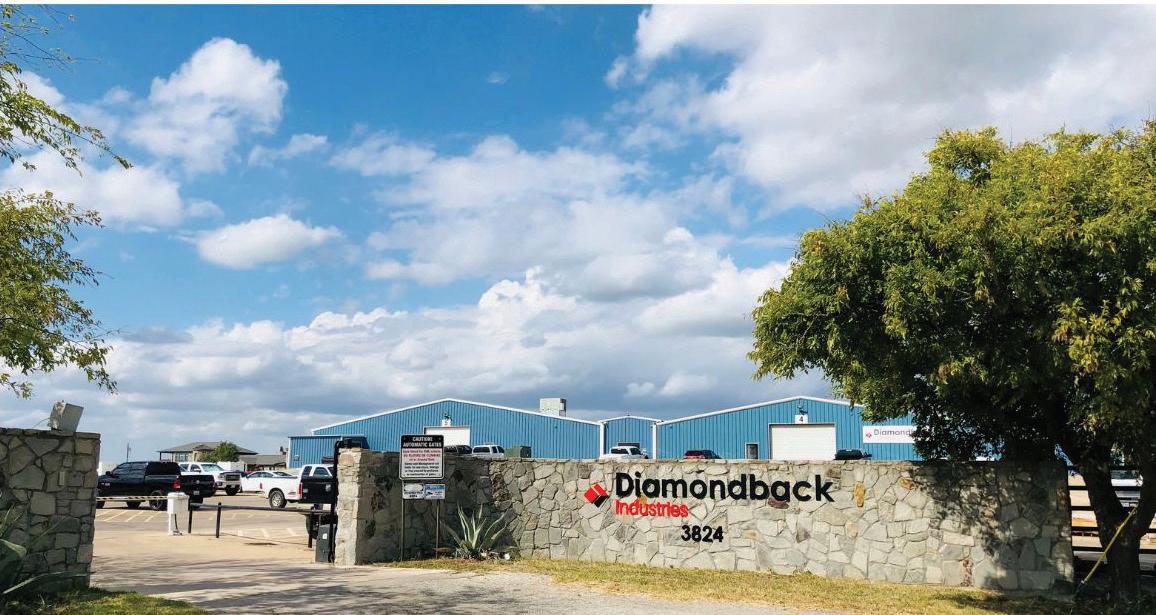
“There are many reasons to locate a business in Tarrant County, including the lower cost of living compared to some larger counties,” says CEO Benton Cantey. “There’s also a very hardworking, smart and diverse workforce, and the county is incredibly business-friendly. While the company’s founders chose to locate here because they lived here, it’s hard to argue against Tarrant County being one of the most friendly business counties in the state of Texas.”
An oil and gas manufacturer of downhole completion tools, ignitors and explosives (also known as energetics), Diamondback serves clients not only in Texas, but nationally and internationally as well. In addition to its headquarters in Crowley, Diamondback maintains offices in Midland and Poteet, Texas; Greensburg, Pennsylvania; and Grand Prairie, Canada. The company currently employs about 150 people.
According to Cantey, Diamondback’s intense focus on quality control and customer service is what sets it apart.
“We do whatever it takes from a quality control and customer service perspective to make sure that our clients are extremely satisfied,” he says, adding that the Diamondback brand name has become synonymous with customer service, innovation, quality and integrity.
The company’s technologically advanced products, which include igniters, disposable setting tools and power charges, are 100% manufactured in the United States.
One of the reasons that Diamondback appreciates being located in Tarrant County is the level of cooperation and collaboration that the county provides. “Tarrant County is fairly hands-off

when it comes to working with businesses—there is not a lot of red tape, which is very nice,” says Cantey.
“Tarrant County College’s (TCC) Corporate Solutions & Economic Development Team is outstanding and very unusual in the resources that they provide to businesses in Tarrant County,” he adds. “It’s a significant asset of Tarrant County and it has become a tremendous resource for us.”
TCC’s willingness to work with local businesses means that companies can find the skilled workforce they need, according to Cantey.
“Not only does TCC train machinists, for example, but we’ve been able to develop a relationship with the machining professor. This allows us to hire top students out of his machining program,” he explains. “If we have specific training needs, we can also call TCC and tell them what we’re looking for, and they go out of their way to train students so that they can come and work for us. It’s fantastic, and it’s a very unusual resource that most counties don’t have.”

In addition to making sure that their customers have everything they need, Diamondback places a premium on employee satisfaction as well. “While we have a deep passion for our customers, our employee family is the driving force behind our daily efforts,” Cantey says. “We have a very family-oriented environment here, and our goal is to be as helpful to our employees as we are to our customers.”
This includes making sure that employees are able to make their kids’ games and other events that are often ignored in a strict corporate culture, and providing unusual benefits that add to employee satisfaction.
“It’s difficult to find good-quality people, so we’ve been trying to create an environment in which our employees want to stay with us for their entire careers,” Cantey says. “This year, we put a new program in place that provides employee parents of school-aged children with $75 per child to fill backpacks with school supplies. We also have a food truck paid for by the company that comes once a week to provide our employees lunch. In an effort to assist with rising gas prices and inflation, we also provided our employees with paid gas cards for a few months.
“We are seeing that these kinds of unique, individualistic benefits help employees want to have careers here,” he notes.
The company is also willing to train prospective employees if they have the right attitude and initiative to succeed.
“We hire a lot of machinists, and while it helps to have experience, if a candidate is hardworking with a willingness to learn and a positive attitude, we can train them to work in most of our positions,” Cantey says.
As for companies thinking of relocating to the area, the CEO is a strong advocate for the benefits of Tarrant County. “Tarrant County is just an easy place to do business, and that is coupled with a talented and hardworking pool of potential employees,” he says.
“It’s difficult to find good-quality people, so we’ve been trying to create an environment in which our employees want to stay with us for their entire careers.”
Though CoreCo USA rebranded itself with a new name in 2020, the geotechnical and environmental drilling services company has always had a home in Tarrant County.
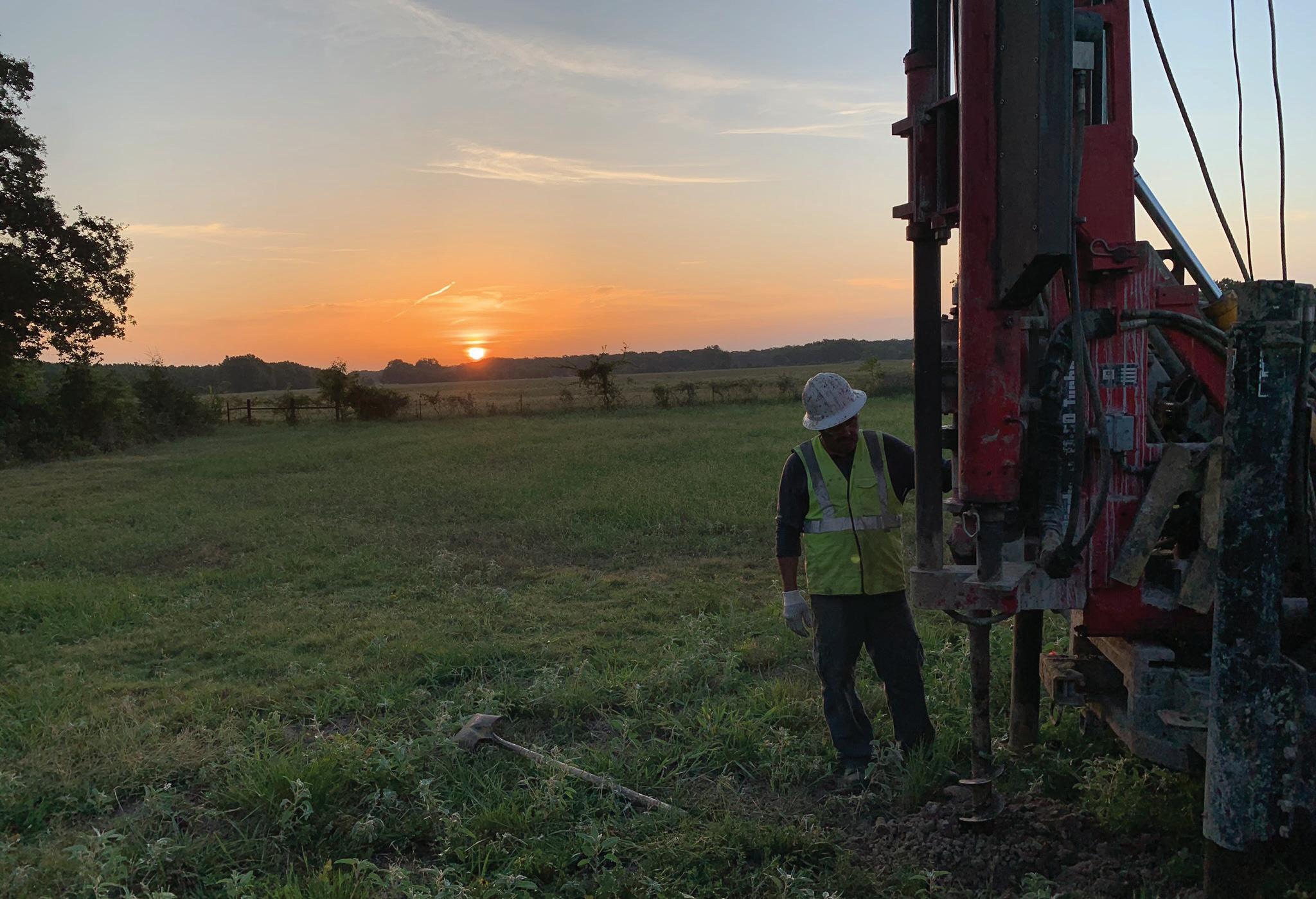

“Our original founders were all from Fort Worth,” explains CEO Gary “Chip” Balk of the company that was previously known as Stratacore/Pinnacle, Inc. “We just never moved.”
Balk is pleased that the company, which is licensed to drill in Texas, New Mexico, Oklahoma, Arkansas and Louisiana, chose to stay in the area for a number of reasons.
“We love Fort Worth; there is a lot of infrastructure here, and we’re an infrastructure company in the Dallas/Fort Worth area,” Balk says. “We can easily get to the west and east parts of Texas. And we also do a lot of work in Austin, so this is a central location for our customers.
“Approximately 90 percent of our 43 employees are from the Fort Worth area, so it’s also convenient for them,” he adds.
Quality of life is important for CoreCo’s employees, and Tarrant County offers numerous amenities for those living in the area.
“That’s a super important factor,” Balk confirms. “Fort Worth has that Texas feel—it’s the biggest small city out there. It doesn’t have the glitz and glam of Dallas or Houston, but there’s a lot to do here including the new Dickies Arena, a world-class zoo and great restaurants. And it’s a safe place to raise a family.”
As one of the larger geotechnical drilling companies in Texas, CoreCo has 12 working crews that provide services to every type of construction client. The company drills at different depths and provides core samples to engineering labs in order to determine the makeup of what’s below the surface before projects can be built.
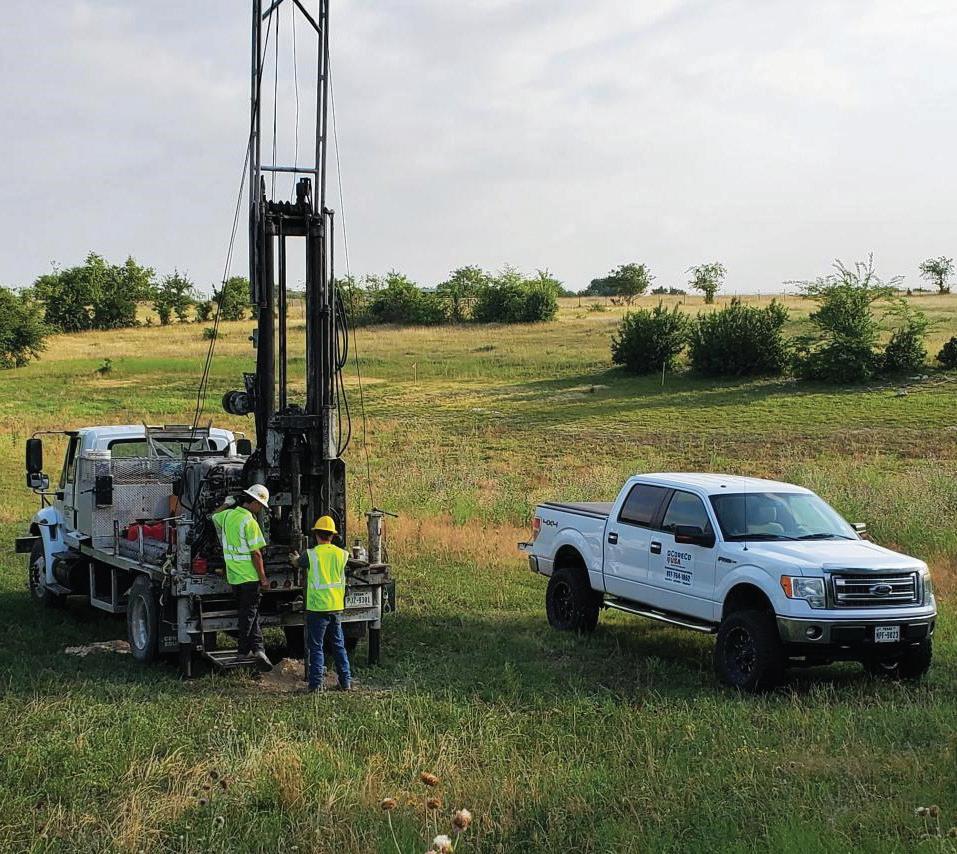
“Nothing is built in Texas or in the U.S. without a geotechnical company drilling a hole; it doesn’t matter whether that’s a house, high-rise, road or a building for Willie Nelson—and I can say that because we’ve been there,” laughs Balk. “Anything that’s being built has to have geotechnical or environmental drilling in front of it.”
One of the reasons that CoreCo has been so successful is because of its commitment to its employees. This year, the company was ranked as one of the best places to work by
Fort Worth magazine and as one of the 5,000 fastest-growing companies in the U.S. by Inc. magazine.
“Our culture is different; there’s no question about that,” says Balk, who notes that employee engagement is key. The company believes in creating a sustainable plan where everyone is empowered to think and safely execute for customers, the industry and each other.
“We spend a lot of time growing our culture to help people build careers,” Balk adds. “McDonald’s can give you a job; I want to give you a career that will support your family long-term.”
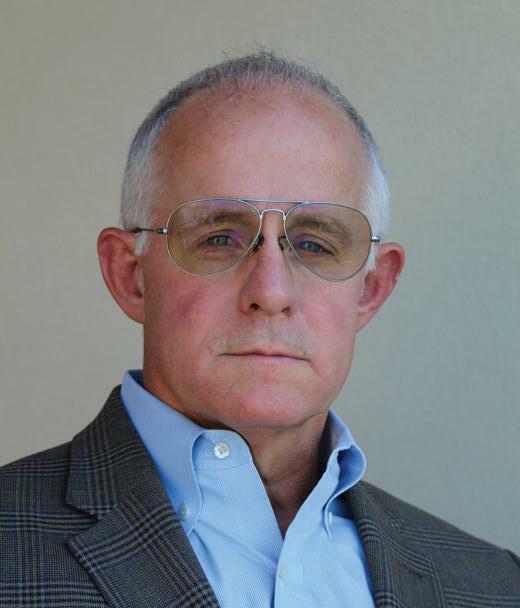
To this end, CoreCo hires military veterans as part of Texas’ “We Hire Vets” program. At the same time, the program is also a second-chance company.
“We have an Air Force base here and there are quite a few veterans in Fort Worth and San Antonio,” says Balk, an Army veteran himself. “We also offer the second-chance program because it doesn’t matter if you’ve had a past; you can build a great career here. And you don’t have to have a college degree.”
CoreCo is also working in partnership with Tarrant County College (TCC) to bring professionalism and awareness to what has essentially been a mom-and-pop industry to this point.
“A lot of people in the field don’t have any formal education or certification; they’ve just received on-the-job training,” Balk says. “It’s super hard to find best-in-class drillers.”
TCC is in the process of assisting CoreCo in developing a curriculum for future employees. “It’s a dying industry because people with 30 or 40 years of experience are aging out and retiring, and there’s no backfill for them.”
Balk points to the presence of a dedicated corporate partner in education as another selling point for the region.
“It’s groundbreaking to be at the front of the industry helping to produce the next batch of drillers,” he says. “There’s such a demand for geotechnical drilling right now that it’s a little wild,” he adds. “There’s no shortage of work; we just need enough rigs and crews to drill it all.”
Gary “Chip” Balk CEO
“Nothing is built in Texas or in the U.S. without a geotechnical company drilling a hole; it doesn’t matter whether that’s a house, high-rise, road or a building for Willie Nelson.”
Though ITS ConGlobal has had an operational footprint by way of its work for BNSF Railway for many years, the company, which aims to be the world’s go-to experts in industrial terminal operations, expanded that footprint with its newest container yard, in partnership with NorthPoint Development, in early 2021.

The company also opened a new office in the AllianceTexas Logistics Hub to support its work and partnership with Hillwood’s Mobility Innovation Zone (MIZ) the same year.

“It all started with the services that we provide for our client, BNSF Railway, which has rail terminals using our services here in Fort Worth,” explains CEO Brant Ring. “The growth in cargo flows through BNSF’s automotive and intermodal terminals to the surrounding AllianceTexas Logistics Park created an opportunity for us to launch a new container yard to support the growth in those freight movements.”
ITS ConGlobal has been working within Hillwood’s Mobility Innovation Zone since its inception.
“We appreciate the welcoming, innovative, businessfriendly environment that is Texas, and especially North Texas,” Ring says. “Here we have access to and great
partnership opportunities with leading higher education—career and technical—institutions; city, county and state government; access to emerging technology companies and leading business enterprises. All of those necessary contributors to innovation are also linked by world-class transportation infrastructure which we can and do support.”
As part of North America’s supply chain, the company’s operational footprint spans the U.S., Mexico and Costa Rica.
“In real terms, we load and unload vehicle and intermodal trains for the North American freight railroads, we position railcars (referred to as switching) for those same clients, and we mechanically repair, store and handle intermodal shipping containers and chassis for the world’s steamship lines, intermodal equipment providers and leasing companies,” Ring says, adding that the company also provides drayage services for shippers, cargo owners and warehouse/distribution centers.
Worldwide, ITS ConGlobal has roughly 3,500 employees, with several operations in Texas, including in Houston, El Paso, Laredo and the Fort Worth area. The company’s operations span the U.S from the East Coast to the West Coast and every area in between.

“In order to make our vision to become the world’s go-to experts in industrial terminal operations a reality, every one of our coworkers needs to have a clear sense for how to measure whether or not—and how—their daily work contributes to progress,” he says of the company’s corporate culture. “That takes us to our mission, which is to take care of each other,
our customers and our business.
“If each one of us can say that we did something to care for one another, to take care of a customer or to take care of business, we can say that we had a good day,” he continues. “If we can point to having done something for all three, then that’s a great day and we are on our way to achieving the vision because we will be safer, we will be more effective and we will be moving the business forward.”
Though industrial terminal operations can be a competitive field, Ring says that ITS ConGlobal spends more time focused on competing with itself than with others, and focuses on honing and improving its business against its own expectations.
“Increasingly, our work in that regard centers on wrapping our operations and services in advanced technology so that we can execute our services safely, effectively and efficiently, and so that we can remain relevant,” he says.
Setting up shop in Tarrant County was easy and straightforward, according to Ring, and he appreciates the continued support that the company has received.

“This has been largely due to partners including local government agencies like Tarrant County and the long-standing partnership that we’ve held with Commissioner Gary Fickes, along with Michael Morris and his team at the North Central Texas Council of Governments; Mike Berry and his team at Hillwood; Jason Byrne and Molly Kanthack at TCU’s Center for Supply Chain Innovation; the good folks at Region 11 Education Service Center and, of course, Shannon Bryant and the team at TCC. All that’s to say we’ve been made to feel very welcome and right at home here in North Texas.
“In addition to all the business-friendly and supportive features that Tarrant County and North Texas offer, it is also a great place to raise a family,” he adds. “We have access to great schools, sound infrastructure, and events and experiences that enrich our lives away from work.”
“If each one of us can say that we did something to care for one another, to take care of a customer or to take care of business, we can say that we had a good day.”
Despite the fact that BrightCrowd’s technology team is distributed all over the country, when CEO T.J. Duane decided where to locate the company’s headquarters in 2020, he chose Tarrant Country for a number of reasons.
“When we moved back to the area in August 2020 from Northern California, we wanted to be closer to family,” he says. “The lifestyle is more laid-back here, and there’s very little that causes stress in a typical day.
“In Northern California, you can’t go a block without traffic and you don’t see that here,” he adds. “It’s much more spacious, and the cost of living is substantially lower.”
While Duane and co-founder and Chief Technology Officer Andreas Zoellner are both based in Tarrant County, the company, which produces digital flipbooks for companies, colleges, universities, high schools and more, has employees in Oregon, California, New York, Indiana, Illinois, Missouri and New Mexico.
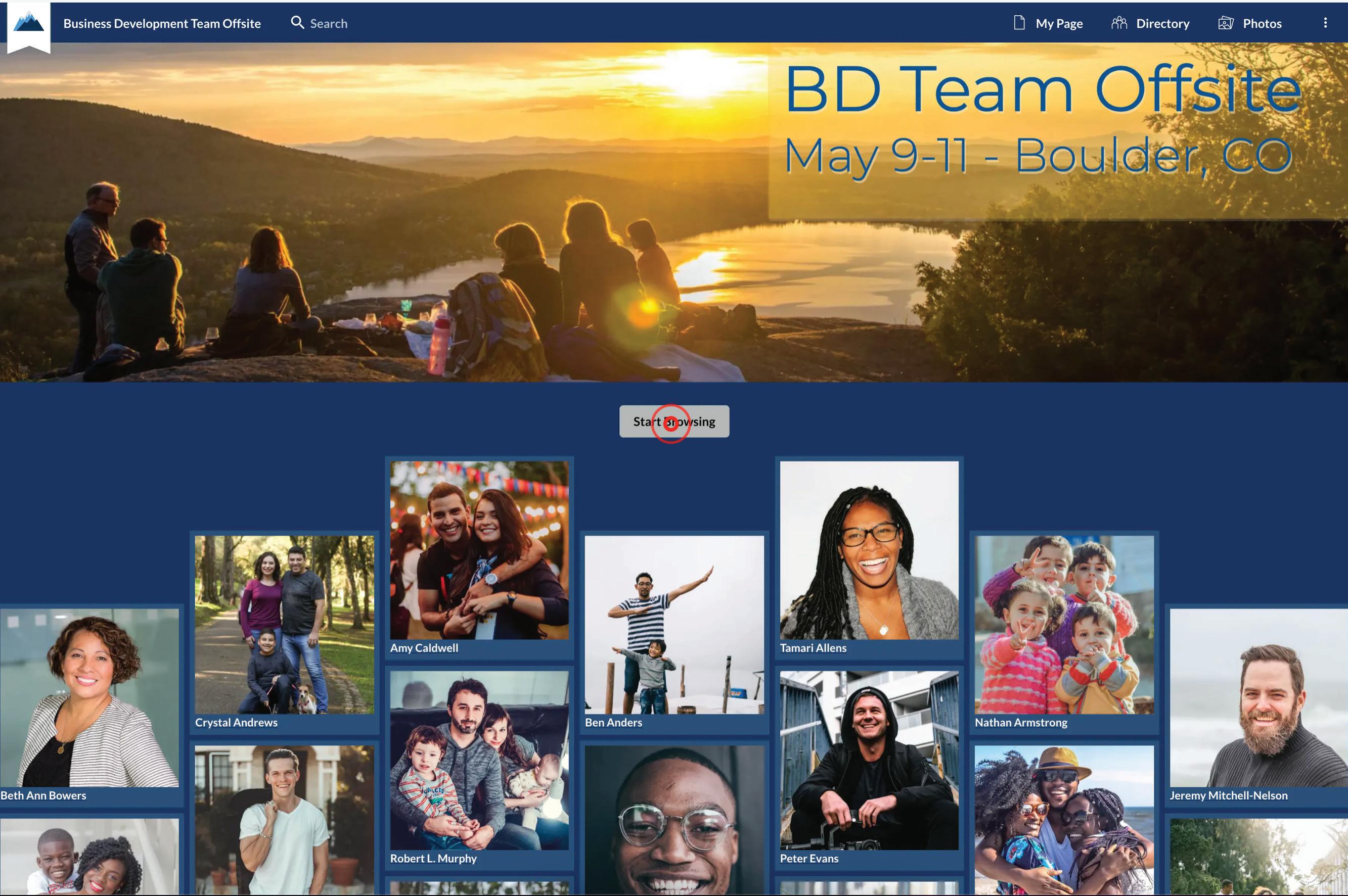
The idea for the digital flipbook was born when Duane was
at Stanford Business School, working with another student to determine a way to offer an alternative to LinkedIn.
“We were trying to take aim at LinkedIn to create a better version with real relationships and connections, and with more detailed skills,” he explained. “It turned out that there wasn’t much of a desire for a better version of LinkedIn, but people were interested in a more private, intimate version of Facebook.”
Facebook’s early days were similar to Duane’s concept of a digital version of a closed group, where everyone knew each other and shared photos and information with people they knew.
Today, BrightCrowd’s digital flipbooks are used by everyone from Ivy League schools and other colleges and universities to Netflix, J.P. Morgan, Johnson & Johnson, company sales forces, technology companies and more.
“While a lot of other organizations use directory software, our main distinction is that we’re more than just a functional tool that includes a name, address and phone number,” Duane
says. “Our books are more experiential. People are able to share their stories, and the flipbook acts more like an icebreaker than a traditional directory.”
Duane says flipbooks give members a chance to present their authentic selves by including photos and stories about what motivates and excites them. “It’s a much richer version of an alumni or employee directory with people sharing photos of themselves and their kids or pets, or hobbies like skydiving,” Duane says. “They can find other members who like to watch Ted Lasso
“It’s about giving people a place to show themselves—not in a way like TikTok or Facebook that is much more promotional,” he adds. “And it’s directed to a very limited audience with whom they have a lot in common.”
For example, uAspire, a nonprofit organization geared to providing young people with the financial information and resources necessary to find an affordable path to and through college, set up the books for a staff retreat in Boston.
“We were so grateful to have BrightCrowd to help our team get to know each other better,” says CEO Jaclyn Piñero. “The platform has been a central and important tool to make early strides in connecting the organization.”
Lorraine Sarles, director of development at the University of Texas School of Law, uses BrightCrowd books for all of its reunions. “The books have been extremely successful with the highest rate of alumni engagement I’ve ever seen,” she says.
In fact, participation rates are five to 10 times higher than participation on social community platforms since more people feel comfortable sharing on a private platform. The books can be launched without any software installation or systems integration, pages can’t be indexed by search engines, and the data is never sold.
The company’s mission is to help people more deeply understand others, and its company culture embraces that goal. “Our team ranges from folks in their 20s to people in their 60s who spend a tremendous amount of time doing customerfacing work,” Duane says. “Working remotely, they spend all day online communicating over Slack, Zoom and email to ensure they don’t just get a sale, but that our customers get a lot of value out of what we’re providing.”
A number of BrightCrowd’s team members worked for decades in higher education in alumni affairs, including at Washington University and Cornell University, which helps them to better customize the product to meet customers’ needs. “Understanding our customers and their pain points is crucial,” Duane says.

While he may have moved back to North Texas for family reasons, Duane appreciates that Tarrant County is a welcoming place to work.
“A lot of tech companies are moving to Texas, and a big part of the reason for that is that it’s incredibly business-friendly,” he says.

T.J. Duane CEO
“In Northern California, you can’t go a block without traffic and you don’t see that here. It’s much more spacious, and the cost of living is substantially lower.”
As a manufacturer of aircraft seating, RECARO Aircraft Seating’s products go all around the world. Yet when the company, which is headquartered in Germany, was looking for a place to serve North and South America, they landed in Tarrant County.
“Back in 1998, one of our biggest customers in the U.S. was American Airlines, and they requested that we have a stateside presence,” explained RECARO General Manager Sunitha Vegerla. “We did a market study and determined that the Dallas/Fort Worth area was the best place to be.
“It’s centrally located to various airlines in the area and across the U.S.,” she continues. “From a logistical point of view, it made sense to be close to the airport and the Gulf, while having well-connected road systems and rail transportation nearby.”
While the location was prime for their business, the access to talent was important, too. “All of the technical universities and schools around us provide a good source for recruiting,” Vegerla says.
RECARO, which has 450 employees in Texas and 2,100 employees worldwide, manufactures seats for commercial aircraft for airlines across the globe. “We manufacture everything from economy-class seats to business-class seats to fullflat seats and the furniture that goes around them,” Vegerla says. “While our products are primarily related to seating products, we do have the competencies for other interiors as well.”

In addition to locations in Fort Worth and Germany, RECARO has production sites in Poland and China, and a sister facility in South Africa that makes fiber composite products for the aircraft industry. In North America, the Fort Worth facility has complete market responsibility for its products from A to Z, including sales, marketing, engineering, production, supply chain, logistics, quality and customer service.
While the company does have competencies in other areas, including the manufacturing of automotive seats, baby seats and strollers, the
primary focus of the Fort Worth location is on aircraft seating, which sets them apart from their competition.
“We are also a family-owned, German-engineered company, which makes our culture quite different from our competitors,” Vegerla says, “and we make sure that this family-oriented culture is reflected in our core values and leadership principles.”
One of the ways in which they do this is by focusing on a long-term strategy rather than short-term financial benefits. “Our first priority is safety, not just in our products, but for our people,” Vegerla says. “We are also focused on developing our people, which is one of the reasons that we offer international exchange programs.”
One program, titled Fly, sends future leaders and “high potentials” through a one-year training program where they work with colleagues from other sites, including the headquarters in Schwaebisch Hall, Germany. “During this year, they get to meet and work with peers at other sites,” she says, adding that RECARO also offers an international exchange program for its Texas employees interested in working in other countries.
The company’s rich benefits program covers every member of an employee’s family at no cost to the employee and they also provide additional perks, such as giving employees who are first-time parents a baby seat as a present. “We want to welcome them to the family with our own products,” Vegerla says. “This is part of being a family-owned company; we take care of our people and that reflects in our work culture.
“While we’ve only been in Texas for 24 years, RECARO has been in business for over 100 years—50 of those years with aircraft seating—and that includes generations of retirees,” she

adds of their success in keeping employees with the company for the long term.
When RECARO considered its location, it also took into account how living and working in North Texas would affect their employees.
“The cost of living here compared to other metroplexes in the U.S. is still affordable,” she says. “It is also a safe area and the schools and universities are very good. It’s a wellconnected community.”
RECARO sees these connections firsthand as a member of the Fort Worth Chamber, which is very active in supporting new businesses in the area.

“The chambers do a good job in connecting businesses by holding meet-and-greets where companies looking to set up a business here can meet other business owners and get their questions answered,” Vegerla says. “This really helps them get the lay of the land before undertaking a market study.”
Personally, Vegerla appreciates the vibrancy of the area and the fact that it is a multicultural community.
“Not only is there a diverse population, but the area provides international exposure as well,” she says. “It is also very active in terms of activities. Regardless of what age you or your kids are, there is always something going on.
“Businesswise, we’re connected to international communities because we work with airlines all over the world, but these connections aren’t just made during business meetings; you find them at home as well,” she adds.
Sunitha Vegerla GENERAL MANAGER
“Not only is there a diverse population, but the area provides international exposure as well. It is also very active in terms of activities.”


and development are critical to recruitment and retention of quality employees. by heide brandes

since 2019, the executive team at Dolese, a full-service construction supply and material operation that employs more than 1,000 people in Oklahoma City, has gathered up their “cohorts” for training and leadership development.
The top management leads a group called Cohort One, which is composed of 16 to 17 employees identified as next level leaders who then work with Cohort Two, a group of roughly 30 other employees. Those two groups then lead and work with a third group called the Supervisor Group.
“These employees have gone through specific programs at the executive team level, and now Cohort One, Cohort Two and our Supervisory Group are actually involved in what we have termed the ‘DLE,’ or ‘Dolese Leading Effectively,’” says Jack Hillemeyer, director of Learning and Organizational Development for Dolese. “It is a two year program that covers a variety of topics from talking about trust, talking about diversity, equity and inclusion; talking about collaboration and accountability
and talking about wellness. While the program is for developing our managers, our supervisors and our directors, it’s really for them to be able to focus on the development of their people and lead their teams better while leading themselves better.”
At Paycom, one of the nation’s leading online payroll services and HR software solutions companies, employee training programs for new hires, career progression and leadership are designed to unlock potential to maximize success. As part of that, Paycom’s Learning and Development team of instructional designers, content creators, learning partners and client trainers focus on equipping a workforce for a lifelong career at the company by providing the tools, resources and support to help the employee
“In an employer-competitive job market, attracting and retaining top talent is a pressing issue across industries. The ability to easily train and engage employees not only gives workers the skills needed to succeed in the tight labor market but moves business forward,” says Jennifer Kraszewski, vice president of human resources at Paycom.
For businesses today, that investment in employees is paying off when it comes to employee satisfaction levels.

Learning and development (L&D) programs are now becoming just as important a recruitment tool as traditional benefit options like retirement savings and health plans. In fact, skills training is one of the top benefits that younger workers look for in a new job, according to a 2021 Gallup survey conducted on behalf of Amazon. In that survey, 66% of workers ages 18-24 ranked learning new skills as the third-most-important perk when evaluating new job opportunities, behind only health insurance and disability benefits.
What’s more, according to the 2019 “Future of Work and Employee Learning” report from Sitel Group, 79% of employees responded that they felt it was important that a future employer offers formal training programs. One-in-4 also said they have not attended training in the past because they felt their manager didn’t think it was important.
Formal training programs and continuing education for employees may be key recruitment tactics, but that same training makes a difference in retention numbers as well. The Sitel group report showed that more than one-third of employees said they would leave their current job if they were not offered training to learn new skills. Yet despite those numbers, 19% of workers say their employers don’t offer any training at all or have lessthan-satisfactory offerings.
“That lack of skills gap understanding can lead to turnover as more than one-third of employees say they would leave their current job/employer if they were not offered training
to learn new skills; emphasizing the growing need for organizations to invest in their people through training and learning and development,” the report concluded.
Workplace training is not only vital for retaining talent but for recruiting new talent as well. Nearly 80% surveyed by Sitel said former training programs offered by potential employers were important to them when searching for a job. Among employees, men are 81% more likely to say a formal training program offered to employees is important, and 88% of Gen Z said it is important to them that a future employer offers this.

“The question is how do we create unique cultures? How do we create unique leadership opportunities and how do we create insights and opportunities to show our employees how we value them,” says Dolese’s Hillemeyer. “We have seen good numbers, but we’re still working at it in a lot of areas.”
It comes down to the fact that when employees feel like their growth is stagnant, they will seek new opportunities
In a recent Gallup survey,
66% of workers ages 18-24 ranked learning new skills as the third-most-important perk when evaluating new job opportunities, behind only health insurance and disability benefits.
Calling Entrepreneurs! Tarrant County College (TCC) is preparing for the third cohort of the Everyday Entrepreneur Venture Fund (EEVF). The EEVF is designed to help small business owners grow their new or existing enterprise through customized education and seed funding. Also, business owners selected for the program will receive mentoring approximately twice a month from business professionals.
Owner/Operator AMP MaterialsLLC
“Having experience in business, bookkeeping, banking and new startups, I took an extreme amount of knowledge from the program. I also gained confidence by realizing my struggles were common after talking with other participants. Overall, all the sessions and courses were very informal and have helped our business growth.”


For more information visit: https://corporate.tccd.edu/eevf/
Arlene Peterson Career Consultant & Grant Writer ArleneSpeaks“The TCC EEVF Program has truly been a blessing. It helped me increase sales and also win more small business grants for my peers in the first cohort as their grant writer! With all of the financial support offered and experiential wisdom that our business advisors shared, I was equipped with the wraparound support needed to not only survive but thrive throughout the pandemic and beyond.”
with companies that provide more training support from the top down. Nearly half of employees surveyed said they felt their employers would penalize them for not having certain skills, and more than 30% of employees said they hesitate to ask for skills training because they think their lack of skills or knowledge would be used against them.
Ultimately, employees who feel like their training and continuing education are not prioritized will have a higher chance of seeking managers at other companies who do. So far, companies like Paycom say the learning opportunities are paying off as a good investment of the company’s resources and time. According to internal polling at Paycom, nearly 9 out of 10 employees said they had opportunities to learn and grow at Paycom within the last year.
“Paycom’s leaders know the value of L&D and believe it is a critical strategic element of the business,” Kraszewski says. “Our success as an organization starts and ends with our employees. We want the best and want to equip them with the tools and resources to unlock their potential and maximize success. This required the intentionality of our strategies and relying on experts in adult learning to lead the charge.”
A successful learning and development program should include both skills training that meets the company’s needs and opportunities for personal development. Even skills that aren’t directly tied to a job—like language classes or personal finance training—can show employees that a company cares about their personal growth as well as the company’s growth.
“Training that’s more connected with purpose and values tends to be better at retention and motivating folks,” says Nadine Levitt, education advocate, author and the CEO and founder of Wurrly, an educational technology platform based in Santa Monica, California. “The concept that we all like to feel capable and we all like to feel like we are continually developing is the driving idea behind this. There is more awareness that the stuff that doesn’t seem linked to your job, like the yoga classes or whatever, may not seem like an obvious investment in your


“In an employer-competitive job market, attracting and retaining top talent is a pressing issue across industries.”
workforce, but there is a lot of research to suggest that if you’re relaxed, if you feel connected or if you feel appreciated, your job satisfaction and outlook absolutely impact outcomes.”
Leaders should have a clear understanding of the objectives of the L&D program with a clear goal in mind. On the flip side, if the department leaders do not have a clear objective or idea of what they hope to achieve by offering training, then the likelihood of success wanes.
Employees themselves can be the strongest resource when it comes to building out a new L&D program. Simply asking employees what they feel are the biggest learning needs and how they would like to learn is the first step. Meeting with HR or supervisors in each department to identify needs or developing a company-wide survey of types of training programs available can also jumpstart a program.
And the investment doesn’t have to be huge either. Companies should look at the resources they already have in place. Employees and leadership both can be an easily-tapped repository of knowledge and information. Other departments may rely on outside vendors or programs or software.
Paycom stands out in the L&D space because the company not only uses education to advance its own team members but is also providing the technology that keeps other organizations’ workforces engaged and productive. To help its clients foster productive conversations of their own, Paycom recently added a collection of diversity and inclusion courses to its digital platform, the Paycom Learning Application. The collection includes key topics such as bias, fostering inclusion, inclusive leadership, hiring diverse talent and more.
“We believe in supporting the whole person,” Kraszewski says. “Employees today are looking for mental, physical and financial health accommodations. They also want to be invested
in work. They want someone to support their career journey. This happens across the organization and doesn’t have to be limited to L&D.”

At Dolese, the 2020 COVID-19 pandemic created a question of how the company would continue its L&D momentum when employees were working from home and the central office was closed. To avoid losing employee engagement, the different “Cohort” teams were broken down into teams of three to five people who would meet once a month over video chat to discuss topics ranging from leadership skills to health and wellness.
“What those coaching circles led to was employees genuinely getting to know those three or four other people that they were in that coaching circle with at a level that would have never occurred,” Hillemeyer says. “It built trust and community. It built on the idea that continual learning was something that was important to the company from the CEO down.”
Ultimately, the goal of any company’s L&D program should be to make every employee feel like they have an opportunity to improve and grow within a company.
“A lot of this professional development and the cultures of companies are shifting to the fact that there is something more to what motivates human beings, and that the collaborative effect of the workforce isn’t just for the top superstars anymore,” Levitt says. “The hidden underlying message is ‘I care about you, I want to offer you something, and this is what I can do.’ It shows your company sees their employees as a threedimensional person, not just as a worker. Participants said that they found it really meaningful in terms of job retention—they like that feeling of appreciation.”
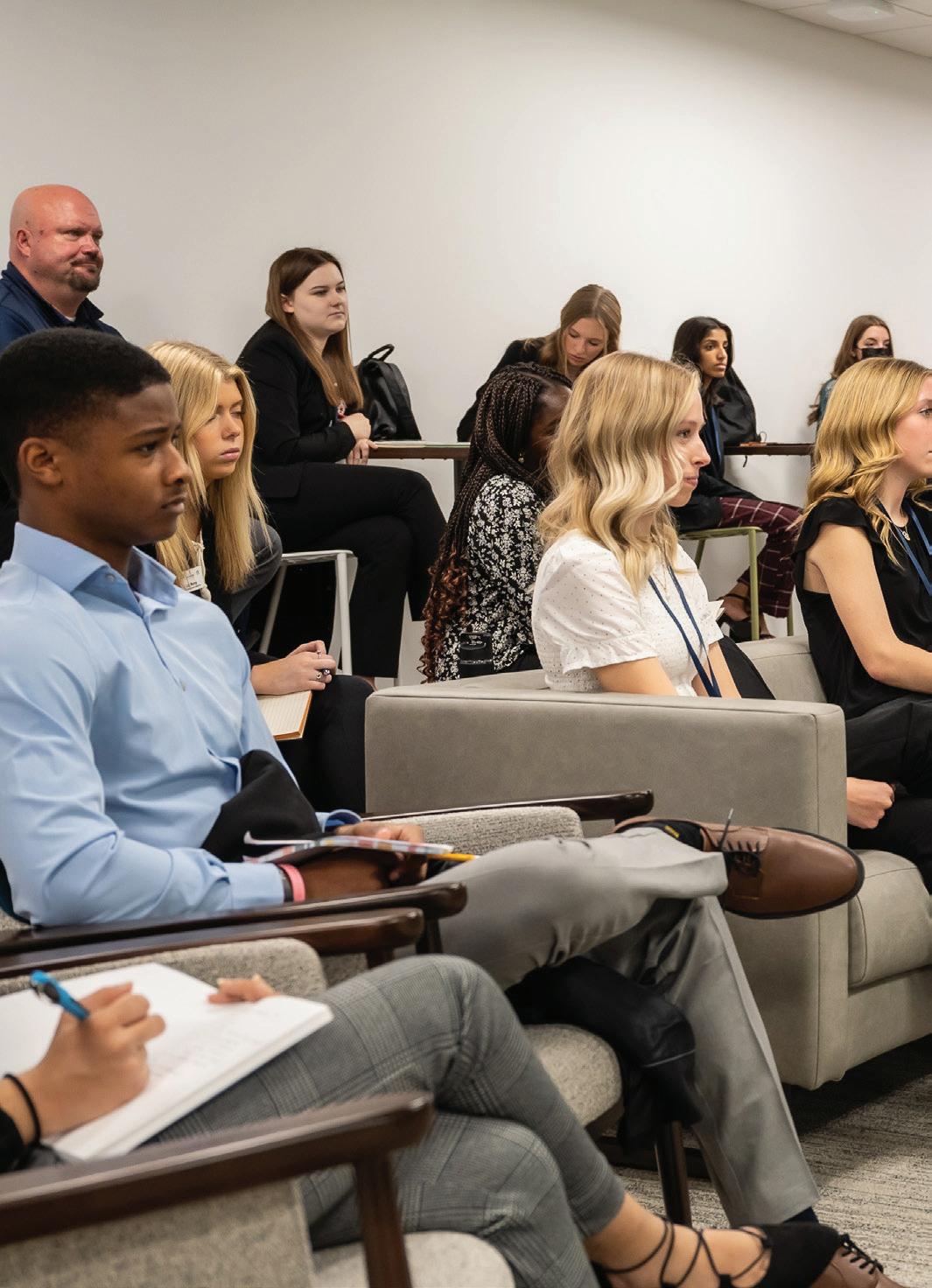

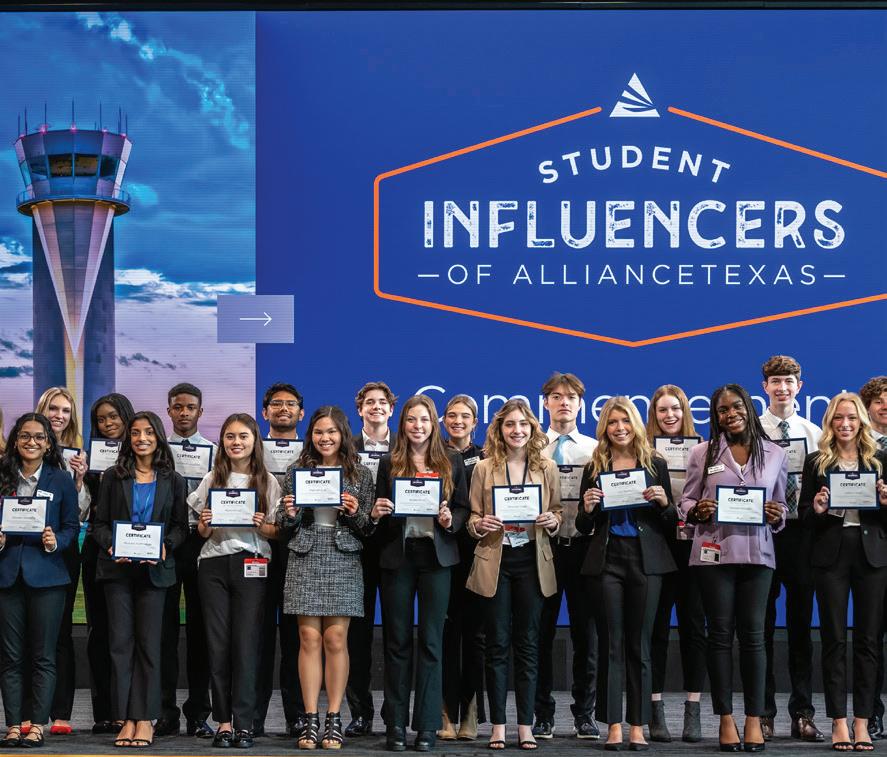

The annual evaluation is being redefined and reimplemented.
by jennifer blalock, eddThe new world of work demands that corporate leaders manage the performance of employees and teams in creative and unique ways. Traditional boundaries, definitions and expectations of employee achievement have been turned upside down. Today’s employees are accustomed to working from home, but managers aren’t comfortable or prepared to evaluate performance without being privy to daily work performance and behaviors. This begs the question:
How can leaders evaluate entire work divisions consisting of hybrid or fully remote work teams?
Add performance twists to increasing workplace trends— including decreased work hours, global and diverse teams, and a premium on work/life balance— and it becomes more complicated to implement effective organizational performance management practices.
In these fluid conditions, it’s no surprise that managers are finding it more difficult than ever to assess employee performance. Overwhelmed by the hype surrounding the Great Resignation, many employers are hesitant to jeopardize the delicately evolving new employer-employee dynamic with performance demands and assessments, as businesses compete to not only recruit talent but retain it. Worries about how to navigate the new landscape of work performance have created an increased scrutiny on the overall process and related policies, propelling some companies to reassess their own employee assessment.
“It’s become increasingly difficult to manage employee performance in light of high turnover, as employees no longer commit to long-term growth with one company,” says James Burda, a sales leader in the North Texas market who manages a hybrid sales team. The Center for Sales Strategy recommends differentiating performance tracking of the individual sales team members from the leading indicators of the entire sales team. “I’ve got to hold my individual salespeople accountable while also managing our combined sales benchmarks,” Burda says. “Tracking is critical, and continuous coaching can make a world of difference.”
Not just reserved for the sales sector, there are also concerns that high accountability measures and demands on employee performance may push workers away in a time of already extensive turnover and record resignations. Employees are more inclined to stay with organizations where they receive performance feedback and are given clear, direct and measurable objectives. Their desire to leave is often triggered by leaders and companies whose direction and guidance on workplace expectations is sparse, if it exists at all.
Here are some useful recommendations to transform your company’s performance review policies and practices into both a competitive advantage and employee engagement and retention tool:
Kick the Annual Calendar to the Curb
Annual evaluations are so last decade. Instead, consider daily, weekly and monthly check-ins and work progress updates. In Dr. Gleb Tsipursky’s 2021 book, Returning to the Office and Leading Hybrid and Remote Teams, he recommends weekly evaluations, which include self-assessment and reporting by the employee; identified accomplishments during the prior week and priorities for the week ahead; and supervisor evaluation and assessment comparing goals to actual achievements. PwC (Price Waterhouse Cooper), a global Fortune corporation, has conducted several surveys to take the temperature of workplaces. One of their key findings is that 60% of employees prefer frequent, informal feedback on a regular basis.
For far too long, performance metrics have been exclusively centered on time, effort and quantitative achievements. New innovations in the amount of time at the office and the way that work time is measured have challenged this myopic way of thinking. From four-day workweeks to abbreviated workday shifts and increased vacation time, the amount of hours an employee spends working is no longer a valid indicator of how well they’ve performed. Instead, consider client satisfaction, retention and other variables such as teamwork, collaboration and communication.


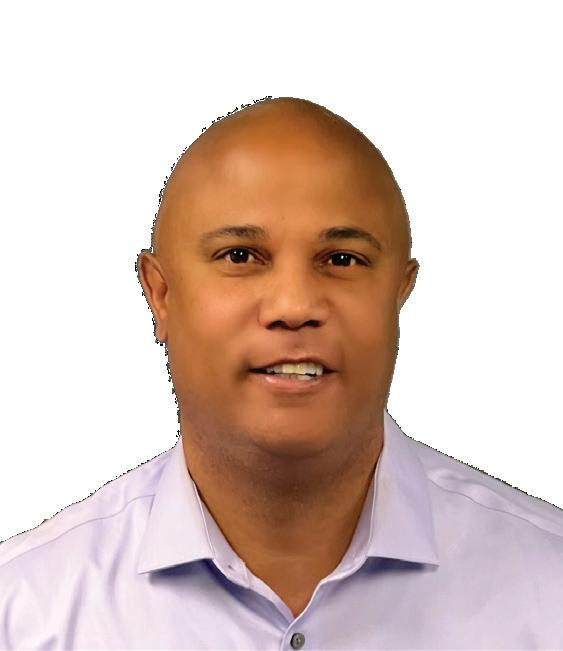
Feedback interactions don’t need to be scheduled or formal. Open up Monday morning meetings by inviting supervisor shoutouts, weekly wins and colleague compliments. Invite and encourage positive performance exchanges by coaching supervisors to model the way publicly for the company and privately in his/ her community.
Make Performance Feedback a Shared Exchange
Sure, the 360° performance review offers employees the chance to provide feedback anonymously and safely to leaders and direct supervisors. But don’t be afraid to open the floor for employees to share their feedback on leadership’s performance, company policies, strategic priorities and more in meetings, open forums and via other communication platforms in a more accessible format than the traditional 360°.
Develop a Template for the Review Educators leverage rubrics for a reason—they provide the student and the teacher with a shared understanding of how the grading system works and what excellence looks like. By developing a shared performance evaluation policy (supporting document and adopted template for the review, including examples for any associated rating), you’re establishing a shared understanding and common starting point for both the employee and the employer to build the conversation.
“It’s become increasingly difficult to manage employee performance in light of high turnover, as employees no longer commit to long-term growth with one company.”
— James Burda SALES LEADER
Ready to dig in even more deeply for your 21st century performance feedback program? Check out these recommended reading resources to help develop your company’s next-gen performance evaluation plan and add them to your bookshelf:

• Feedback Mentality: The key to unlocking and unleashing your full potential by Dr. Shanita Williams
• HBR Guide to Performance Management by Harvard Business Review
• How to Give Employees Performance Feedback & Resolve the Resistance You Know You’re Going to Get! by Ross Blake
The employee performance review, whether weekly, monthly or annually, involves at least two people. Thus, the learning and development process and the employee’s access to the resources, such as the evaluation form and associated rating scales or rubrics, should reflect that. Certainly, supervisors need to be trained on and fully understand the company’s performance policies, but the employee, too, deserves an opportunity to learn about, question and consider the process so they can prepare and participate fully by performing accordingly all year long. That will also help employees who are promoted into management roles in the future.
Prove your case and support your feedback by citing specific examples. Focus on what the employee did well and help draw the path forward to improving performance by identifying areas of improvement with detailed recommendations and ideas. Make sure to celebrate the good news. When an employee is doing great things at work, don’t just tell them about it in a performance review. Share it with the team, with the company and with
the community. For performance feedback to become more of a positive and collaborative experience, celebrating positive performance is a must and will go a long way in debunking any organizational concerns about the nature of performance reviews in your company.
Employees can’t be held accountable if your company’s performance evaluations aren’t clear and consistent. Communicate company benchmarks, organizational goals and milestones clearly and rate everyone’s performance consistently. Connect to organizational and individual goals.
The only certainty in the performance feedback process is change. More shifts are likely to come as the world of work reshapes and aligns to respond to new organizational norms. The most effective performance feedback programs will remain agile and proactive, anticipating the prioritization of continuous development and workplace achievement for both the individual employee and the organization. Prepare your company today to lead your employees to their fullest potential with an innovative performance feedback program that lights the path ahead.
Tarrant Small Business Development Center (SBDC) provides management and technical assistance to local small businesses and aspiring entrepreneurs throughout Tarrant County The consulting services provided are at no cost and training services are at a nominal fee.




Business consulting services are customized, one on one face to face or virtual at no cost Consulting services provided are business plan development, capital acquisition, marketing, regulatory compliance and more. The Tarrant SBDC provides services to a diverse population, including special emphasis groups; women, minorities and veterans who are seeking to start or grow their business
The Tarrant SBDC is hosted by Tarrant County College and is one of twelve field centers of the North Texas SBDC Network Funded in part through a cooperative agreement with the U.S. Small Business Administration (SBA). SBA’s funding is not an endorsement of any products, opinions or services.



Some employers are proactively instituting mental health initiatives in the workplace. by james ndone, phd | illustarion by lisa bair

These days, employers are becoming more proactive in supporting employees’ mental health. Although the global pandemic shined a light on the necessity for mental health needs to be addressed in the workplace in times of crisis, employers are now more active than ever in developing initiatives that promote employees’ mental health early on.
According to the U.S. Substance Abuse and Mental Health Services Administration, 1 in 4 Americans over the age of 12 suffers from mental or substance-use disorders. Research from global consulting firm McKinsey & Company suggests there was a sharp spike during the COVID-19 pandemic, making employers
more concerned about their employees’ productivity and behavioral health.
Another report from the U.S. surgeon general acknowledges that America is at a health disadvantage where people spend a lot of money on health care, but the outcomes are not commensurate with the money spent. According to the report, having a healthy workforce is critical for economic development and recovery. Ignoring the importance of mental health will create an unhealthy workforce due to the lack of a healthy community from which workers are drawn.
“Some common red flags employers need to pay attention to are absenteeism, frequent sick call-ins, inability to meet production
targets and high turnover rates,” says Licensed Independent Clinical Social Worker (LICSW) Zadok Nampala, based in Minneapolis.
Before the pandemic, data from the American Psychiatric Association revealed that employees with unaddressed depression experienced productivity reduction to the tune of 35%, leading to a loss of $210.5 billion a year due to increased medical costs, absenteeism and reduced productivity.
Usually, unaddressed mental issues are associated with the stigma surrounding mental health. The National Alliance on Mental Illness (NAMI) reports that 8 in 10 employees say stigma prevents them from discussing their mental health and seeking treatment.
“There is a lot of shame and stigma surrounding mental illnesses, where people with mental issues are perceived as weak,” says Nampala, who has been working with companies to bolster their mental health awareness programs for over 15 years.

Nampala notes several observed causes of mental health issues among employees.
“Some managers and supervisors are condescending and tend to micromanage their juniors, and this leads to burnout, which is eventually manifested in a desire to quit or look for new
challenges elsewhere,” he says. “Some employees also struggle with the work-life balance, destructive feedback and unfair promotions [of others], which result in mental breakdowns.”
Mental health conversations have become a norm in some organizations, with efforts stretching back before the pandemic. For instance, some employers took a proactive approach in identifying symptoms such as anxiety and depression. Large organizations started training managers to recognize mental health issues affecting employees, with some digital tools and software training programs teaching managers how to detect employees’ distress.
The American Psychological Association (APA) has noted several organizations that have been at the forefront in making employees’ mental health a priority. One of the organizations is Blackrock, a multinational asset management organization that has launched initiatives to promote mental health, such as a company-sponsored subscription to the Calm app (for meditation). Also, Blackrock created a peer network of mental health ambassadors in addition to bringing on board an assistance
“There is a lot of shame and stigma surrounding mental illnesses, where people with mental issues are perceived as weak.”
— Zadok Nampala
LICENSED INDEPENDENT CLINICAL SOCIAL WORKER
According to a survey conducted by the Society for Human Resource Management (SHRM), 88% of HR professionals believe offering mental health services is critical to increasing employees’ productivity, with 86% believing that doing so can boost retention. Organizations should create relevant mental health policies and conduct regular training for supervisors and managers to spot any employee mental health incidents. Employers need to ensure that mental health is not a taboo topic in the workplace, and they must play a key role in promoting an environment that encourages employees to open up and talk about their mental issues with trained professionals.
provider to offer its employees several mental health benefits like virtual care.
Another organization that has been focusing on employees’ mental health is the YMCA. When the pandemic began, it initiated virtual coffee chats to connect employees. It also convened a Mental Health Thought Leader Cohort that initiated a “To Go” package with mental health kits. Moreover, the YMCA came up with Dinner Table Resilience, which offers videos and other tools that staff and members can utilize during family dinners to build resilience.
F5 Networks, a Seattle-based technology firm, added therapy services to employees’ medical coverage. These initiatives were similar to those adopted by global consulting firm Ernst & Young; the National League of Cities (NLC), a nonprofit organization for municipal governments; and the American Public Health Association (APHA). This Washington-based organization champions the health of all people and other communities in the D.C. area.
Still, for Nampala, employers have generally not done enough to promote mental health awareness in the workplace, but he likes the upward trajectory. There is a lot that needs to be done, and in time, Nampala believes that offering mental health services will help a potential employee decide whether to apply.
“From my experience with counseling and working with employees, there is room for improvement,” he says. “Some employers have tried, but some need to take employees’ mental health seriously.”
Although Nampala points out that workplace mental health efforts are more imperative today, he also offers suggestions on how employers can continue promoting mental health in the workplace.
“Employers need to understand mental health is a critical aspect of employees’ well-being,” he says. “Coming up with mentorship programs, mental health onboarding, just like employers do orientation, can help organizations foster proactive mental health programs.

“Some organizations give bonuses to employees who go to the gym for a certain amount of time or days. What is preventing such employers from offering bonuses to employees when they visit their counselors and therapists?”
Nampala suggests that employers and employees should normalize the dialogue about mental health and make it a regular workplace conversation. There is also a need to eliminate the stigma surrounding mental health.
“We need to kill the ‘weakness’ tag regarding mental health,” says Nampala, who has a waitlist of over six months. “Such a long waitlist shows how significant mental health services are.”
As businesses return to normalcy, there is an opportunity to create a mentally healthy workplace culture and mechanisms that organizations should have installed a long time ago, he says. This will bolster employees’ productivity and reduce the chances of mental breakdowns.



Like all employees at The Fulcrum Group, apprentices who work for the information technology support company will learn an important lesson early in their training: Good work starts with a smile.
Customer care is essential to excellence in the IT support industry served by Fort Worth-based The Fulcrum Group, says co-founder David Johnson. Johnson, who co-owns the company with Steve Meek, teaches employees to keep mirrors by their desks so they can look at their reflections while talking to customers.
“Are you smiling while you’re talking?” Johnson asks his employees. “When somebody’s having an IT problem, they’re having a bad day. Smiles help.”
Now in its 20th year, The Fulcrum Group joined the CompTIA Apprenticeships for Tech program in March 2022. The U.S. Department of Labor funds the apprenticeships to help companies access a more diverse and inclusive labor pool, expand current employees’ skill bases, and recruit and train new prospects.
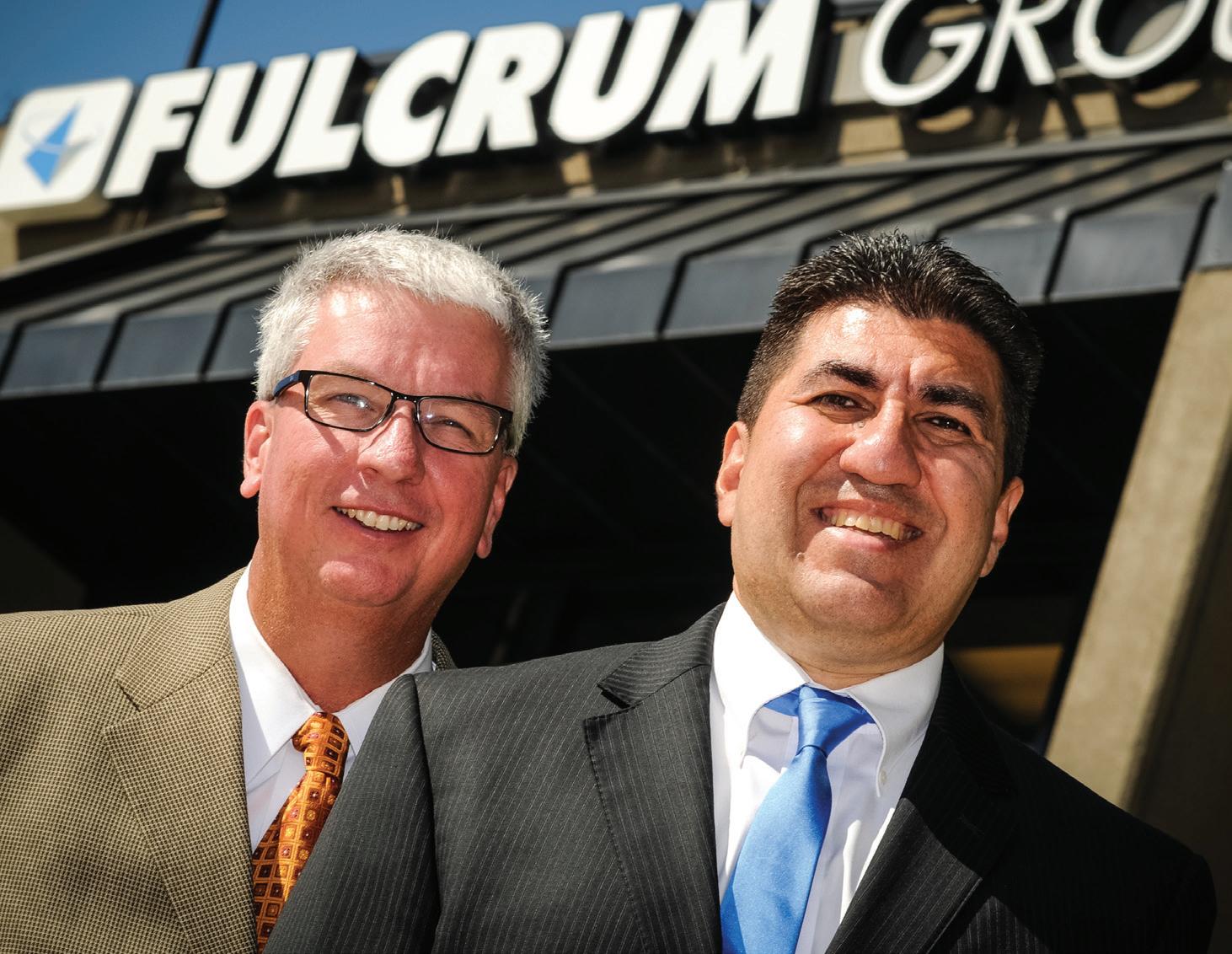
Part of a national initiative to solve longterm staffing shortages, the apprenticeship program at The Fulcrum Group is a sixmonth paid “earn and learn” program. Johnson says the apprenticeships are a “win-win” for the company and the apprentice. Apprentices are paid $15 per hour, and the government reimburses the company for a portion of those wages.
The managed IT company’s clients include local government, health care, professional services and manufacturing businesses. The Fulcrum Group employs 23 full-time staff, and Johnson says once the apprenticeship program gets going, the goal would be to have several trainees
turn into permanent employees.
“The world is changing so much, and the concept of traditional college, while it’s awesome and great, doesn’t fit every person,” Johnson says. “We hope to take some of the apprentices who are the cream of the crop and have them join us, to help us grow our tech skills.”
Johnson and Meek have a lot of lessons to share—they formed their company after working together at tech companies that failed when the internet bubble burst in the early 2000s. The Fulcrum Group started operating out of a small server in Johnson’s house, and the owners used their credit cards to help expand the company’s credit in those early days. Johnson says he and
Meek were inspired to launch their apprenticeship program because they love to give back to the community.
Apprenticeships help people interested in careers in IT “build a foundation,” Johnson says. This is why The Fulcrum Group’s apprenticeship program starts with work on the service desk. Customer service, good listening skills, record-keeping and problemsolving are the keys to helping solve customers’ technical problems.
Johnson says by assigning apprentices to tasks like the service desk, where they learn and utilize broad skills, The Fulcrum Group will be able to evaluate potential permanent employees’ on-the-job learning skills. It can be hard to find qualified people to fill IT jobs, and like many IT companies, The Fulcrum Group needs more workers. Johnson says the technology landscape is changing, and the skills his employees need are different from those needed 15 years ago. Bringing in new talent helps the company add fresh perspectives and skills.
The six-month apprenticeship includes a 90-day probationary period. Apprentices who stay the full term of the program could be offered full-time jobs, or they may receive recommendations for other companies that serve as better fits. Johnson says he and Meek hope they can use their participation in the program to inspire people to make long-term plans to work in the tech industry.
Apprentices get a full onboarding where they learn The Fulcrum Group’s core values and company culture. Fulcrum uses the acronym “TIPLAW” to organize its core values: Take personal ownership—responsibility guides success
Inspire client confidence—confident employees reassure clients

Plan, do, review—checklists help with project planning, execution and review
Look to the future—goal-setting and skill-building are key to the future
• Actively listen and communicate—learn to listen first
• Work as a team—the company is worth more as a team than as individuals
“Somewhere in there should be an ‘F’ for fun,” Johnson says.
“Are you smiling while you’re talking?” Johnson asks his employees. “When somebody’s having an IT problem, they’re having a bad day. Smiles help.”
Just because you made it into the major leagues doesn’t mean you’ve reached the top. by dan schlossberg | illustration by samantha ozeale tucker
Former New York Yankees manager Billy Martin once said his job was to keep the five guys who hated him away from the five who were undecided.
In baseball, as in business, proper supervision of personnel is a vital component of success. But even the most properly supervised baseball player needs to have his or her own game plan, also as in business. That’s because you never know what a volatile owner or manager might do.
Yankees owner George Steinbrenner—who hired and fired the similarly-volatile Martin five times—got upset once after hearing about abuses in the media parking lot, where there was no charge to enter. So he traded places with the supervisor of the lot before a game and greeted drivers personally. One unknowing impostor, begging to enter, said, “But I’m a personal friend of George Steinbrenner!”
The parking lot supervisor was let go.
Then there’s the story of the 1962 Mets. They were terrible and they knew it. In fact, they knew they were always a game away from the chopping block of baseball unemployment, so the smarter ones among them hedged their bets and had a Plan B. Jay Hook, the pitcher who won their first game after nine consecutive losses, was an off-season mechanical engineer. He could explain the dynamics of a curveball perfectly; he just couldn’t throw one. Elio Chacon, the shortstop, didn’t bother to learn English because he knew he’d be returning to his native Venezuela, where he was a national hero, to

pursue business opportunities after baseball.
Players today are well-compensated for their work. But even if they overcome the string of formidable obstacles they will face en route to the major leagues, most of their careers are short, leaving them without many job opportunities unless they stay in the game as coaches or broadcasters.
The key for them is exactly the same as the key for today’s workforce: Always have a Plan B.
When life throws curveballs, as it often does, don’t swing at the bad ones: Have the discipline to wait for the right pitch.
Jim Lonborg, who pitched the underdog Boston Red Sox into the 1967 World Series, became a successful dentist in Massachusetts. Curt Flood proved such a talented artist that St. Louis Cardinals owner Gussie Busch commissioned him to do a family portrait. And Juan Marichal, an accomplished skin diver, was hired to photograph sharks off the coast of his native Dominican Republic.
Between stints as a Yankees infielder and American League president, Bobby Brown was a Fort Worth cardiologist.
“Baseball gave me the financial opportunity to put myself through medical school,” Brown once said. “The experience of playing with those truly great Yankee teams [of the ’50s] was a tremendous influence, enabling me to adapt to all types of crises. The atmosphere of total dedication on those teams will last with me forever.”











 In “The Workforce Lens” podcast, moderated by TCC Executive Vice President for Corporate Solutions & Economic Development Shannon Bryant, MEd, CWDP, LSSGB, we connect with business leaders in Tarrant County and North Texas on the evolution of their workforce needs, focusing on how they will continue to grow and thrive today and beyond. Listen to the podcast at corporate.tccd.edu and check back regularly for new episodes.
Monthly conversations with DFW business leaders.
In “The Workforce Lens” podcast, moderated by TCC Executive Vice President for Corporate Solutions & Economic Development Shannon Bryant, MEd, CWDP, LSSGB, we connect with business leaders in Tarrant County and North Texas on the evolution of their workforce needs, focusing on how they will continue to grow and thrive today and beyond. Listen to the podcast at corporate.tccd.edu and check back regularly for new episodes.
Monthly conversations with DFW business leaders.
The workforce of tomorrow will look different from today –are you ready? We can help, creating customized learning and development solutions to help you grow and thrive. Let us host your team at our new Corporate Center for Learning and Development, located in Alliance. We’re here to meet your business needs –today and tomorrow.














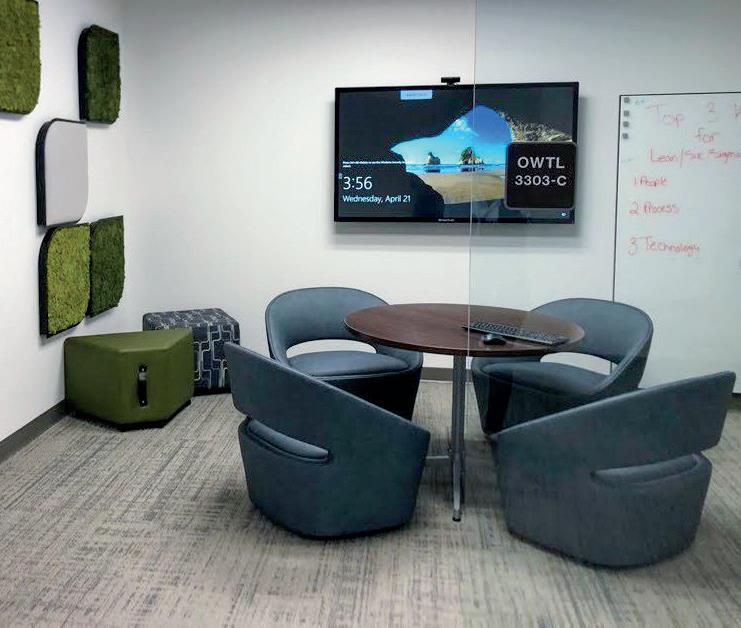


corporate.tccd.edu
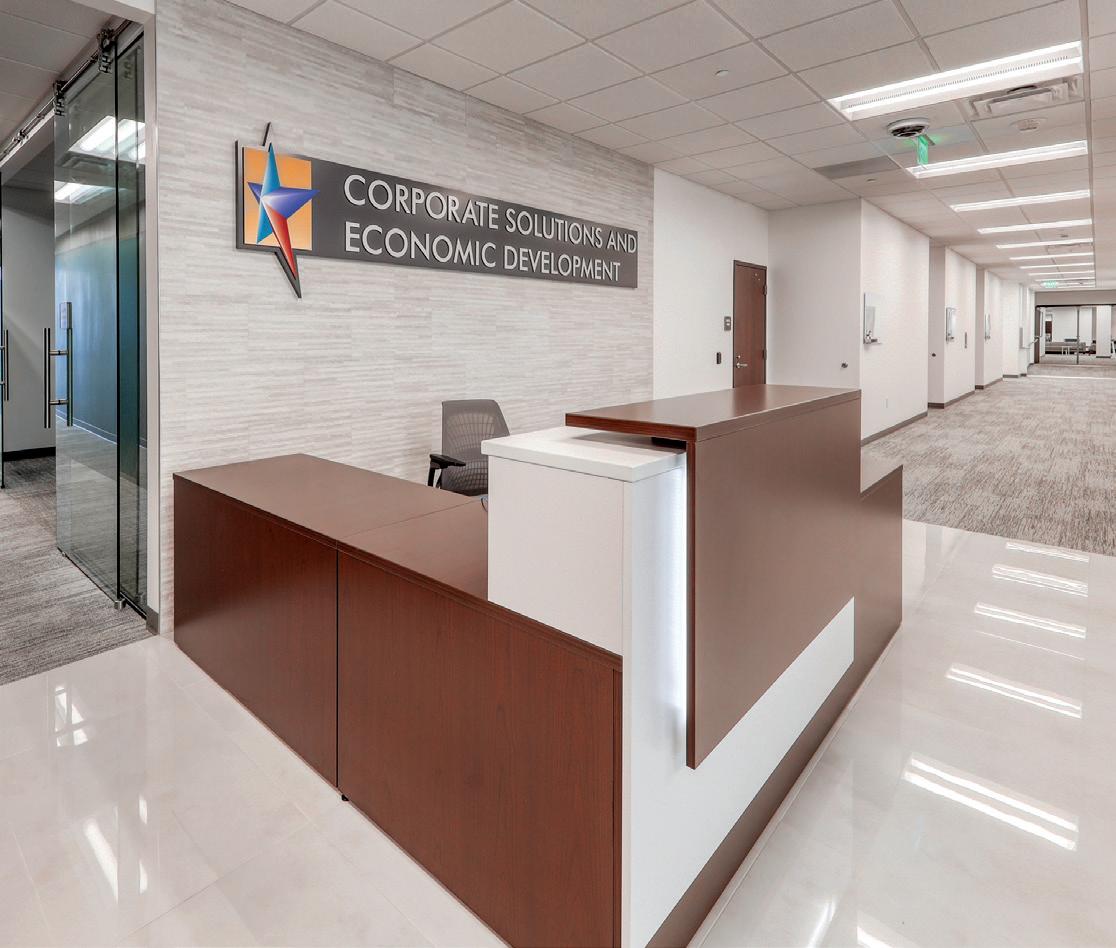
North Texas has a new home for customized workforce solutions.